For the Love of Flowers – The 4 Loves
by Yik Han
Amongst the fine tomb sculpture found in Bukit Brown are depictions of men in the company of flowers. Lest one gets the wrong impression, these are actually based on four historical personalities from ancient China. Collectively, the carvings form a set known as the “4 Loves”.
The peony (牡丹) is known as the king of flowers not without good reason. During the reign of Emperor Xuanzhong (唐玄宗), the Tang Dynasty was at the height of its power. The opulence of the Tang capital, Changan, was known far and wide and the residents lived a lavish life of luxury. The Emperor was a lover of the peony and his palace was filled with breeds from all over the empire. His fondness for the flower was only surpassed by his affection for his favourite consort. At a palace banquet to celebrate the full bloom of the peonies, the Emperor called upon the poet Li Bai to compose a poem fit for the occasion. The intrepid Li Bai readily came up with a verse which likened the beauty of the flower to that of the Lady. This lady, who was to inspire poems through the ages, was none other than Royal Concubine Yang (杨贵妃), one of the four classical beauties of ancient China. She was to meet an ignominious end when disgruntled generals demanded that she be put to death. Till today, the vivacious peony retains its traditional association with wealth and prosperity.

The Emperor is easily recognized by his stately robes, and his palace attendants hover near as he admires his beloved peonies. (photo Yik Han)
In contrast with the celebration of the material life during the Tang, learned men of the Song Dynasty advocated the cultivation of the inner spirit. A weak and corrupt administration coupled with reverses against foes abroad led to many shunning officialdom, preferring instead the life of a recluse to uphold one’s principles and dignity. The favoured flower of this period was the plum blossom (梅). Its delicate feminine beauty belied the indomitable spirit attributed to it as it blooms during the harsh winter months. The story of Lin Bu (林逋) and his beloved plum blossoms epitomised this trend. Lin, who lived a simple and quiet life during the Song Dynasty (960-1279), was interested in neither fame nor riches. A bachelor all his life, he indulged himself in cultivating plum trees and rearing cranes to such an extent that his contemporaries said that “the plum tree is as his wife and the cranes his children”. The plum blossom’s stoic beauty saw its adoption as the national flower of the Republic of China (ROC) in 1928.
Unlike the plum blossom with its lofty attributes, the chrysanthemum is a much simpler creature which represents the carefree life. Tao Yuanming (陶渊明) was a Song Dynasty poet who chose to stay aloof from court intrigues and retired to spend his days with his beloved chrysanthemum flowers. The state of mind which transcends all cares has been captured in his own verse.
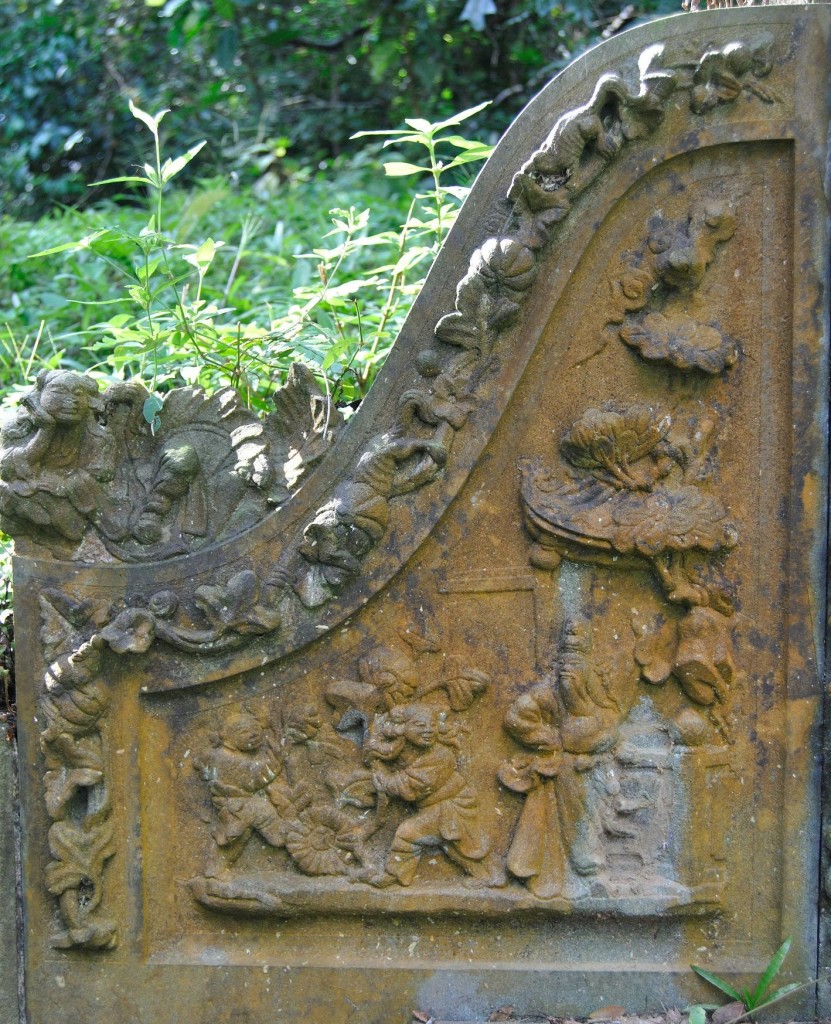
Tao Yuanming in his humble garb tending to his chrysanthemums, easily recognisable by their many petals.(photo Yik Han)
采菊东篱下 悠然见南山
“While picking asters ‘neath the Eastern fence
My gaze upon the Southern mountain rests”
(Translation by Yang Xianyi and Gladys Taylor)
The last of the quartet, the lotus is known for its association with the Song philosopher Zhou Dunyi’s (周敦颐). The “Ode to the Lotus”, arguably his most popular verse, explains his preference for the lotus above all other flowers.
自李唐來,世人甚爱牡丹。予独爱莲之出于泥而不染,濯清涟而不妖 。
“Since the Tang Dynasty, many love the peony. My fondness is solely for the lily as it stays pure even though it grows in mud. After cleansing with water, it does not become bewitching.”
The lotus flower has often been taken as an allegory of how a gentleman should behave, abiding by his principles while navigating the treacherous paths of the world.
In Bukit Brown, carved panels depicting the “4 Loves” can be found on the shoulders (the stone slabs adjoining the tombstone) of tombs from the 1920s and 30s. Usually, only two of the flowers are depicted; only where there are double tombs with four tomb shoulders to utilise will the full set be present. One of these rare examples is the double tomb of Tok Cheng Tuan and his wife which is due to make way for the new highway.
The four flowers have an additional association with the seasons as they are supposed to bloom at different times: lotus (summer ), peony (spring), chrysanthemum (autumn), plum (winter). This is thematically similar to the grouping “Four Friends of the Seasons”, a favoured theme for objects adorning the study and implements of the literati, in which the bamboo is substituted for the peony. In addition, a variant of the “4 Loves” encountered in traditional Chinese art uses the association of the poet Su Dongpo with ink stones or geese. This variant has yet to be encountered in Bukit Brown.
Other posts by Yik Han on tomb aesthetics:
They are among the world’s brightest, nominated for leadership, talent and contributions in the social and economic spheres to the World Economic Forum of Young Global Leaders.
40 of them dropped in at Bukit Brown on 23 October 2012, as part of a programme there were attending at the Lee Kuan Yew School of Public Policy. Volunteer Guides, Claire, Catherine, Keng Kiat and Millie took them on a one hour and half tour which only managed to cover three tombs but we still covered a lot of ground in history, heritage and civil engagement.
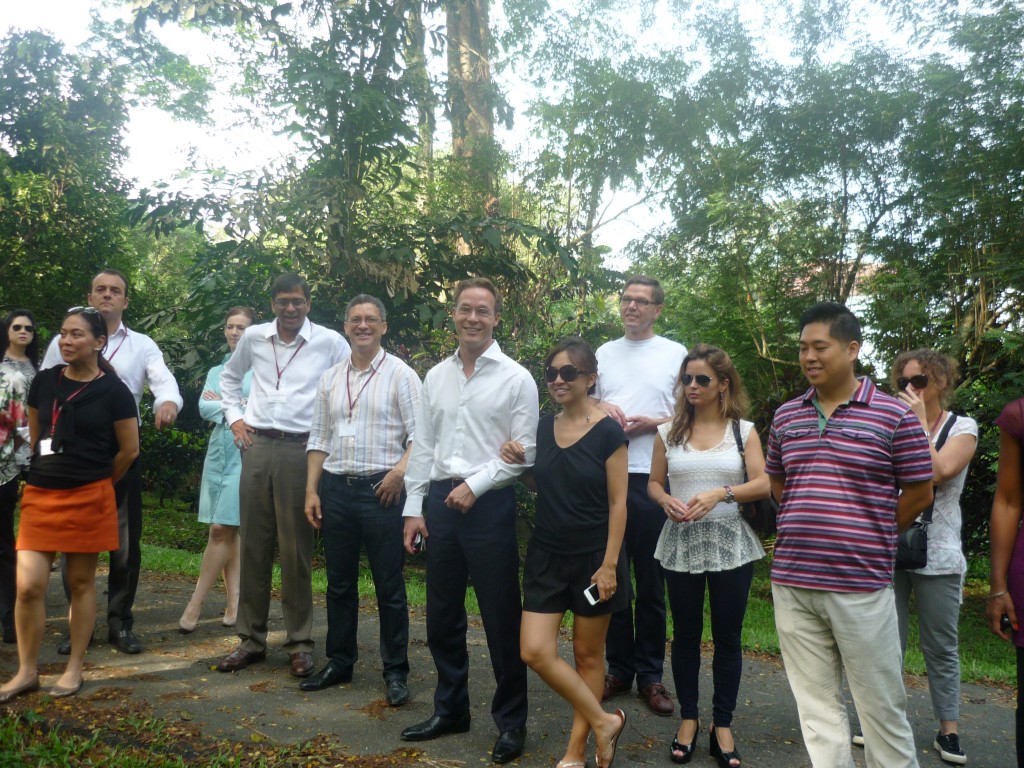
Our best dressed participants to date, and attentive. Impressed by the women who came in high heels and wedgies who climbed with us (photo Catherine)

A wheel chair participant getting assistance from his team members to the tomb of Ong Sam Leong located at the highest point in Bukit Brown (photo Catherine)

Mates Jaime and Marco help Christian get up to see Ong Sam Leong’s grave, with his wife making sure all are in good shape (Photo: Claire Leow)

Back into the classroom, and a robust discussion on development, after a short presentation of Singapore History from colonial times when civil society had much to contribute under the British” laissez faire” adminstration compared to present times, when the state has stepped in with providing more social services. Vice Dean of Academic Affairs, Kenneth Tan helmed the one hour session (photo Catherine)
Tour report: Photos by Philipp Aldrup. For more photos, click here
This is what Bukit Brown looks like in early morning
And this is what early morning participants look like at 7.30 am
And if you want to know more about Philipp the photographer please visit his page
—————————————————————————————————————————–
Time 7.30am – 10 am
Keng Kiat (97903886) guiding.
We will not be visiting the biggest tomb, nor the colourful Sikh guards.
Highight is Keng Kiat will show and tell the mystery of a tomb which looks like a tortoise, has elephants and the name of the occupant means “golden tiger” . It is the latest, significant “discovery”
Register here just to keep track of numbers turning up.
==========================
After the main gate, go ahead another twenty metres, to the right of the SLA officeFor information on how to get there and handy tips please visit
http://bukitbrown.com/
Optimally the group size is 30 participants (15 individuals/guide).Please click ‘Join’ on the FB event page to let us know you are coming, how many pax are turning up, or just meet us at the starting point at 9am. We meet there rain or shine.
==========================
The tour:
The Bukit Brown area is about 233 hectares in extent, bordered by Lornie Road, Thomson Road and the Pan-Island Expressway. It lies just to the south of the Central Catchment Forest, being separated from it by Lornie Road and includes Singapore’s only Chinese Municipal Cemetery. With more than 100,000 graves, Bukit Brown is also one of the largest Chinese cemeteries outside of China.
Don’t forget to bask in the peaceful surrounds, and also chat with your guides and make friends with other participants. We are amateurs and volunteers, but we are passionate and serious about what we do at Bukit Brown, and we encourage sharing of knowledge.
Here is a map of the grounds:
http://bukitbrown.com/
==========================
Please take note:
1. We will be walking mainly on paved roads. But there are hill treks so dress appropriately, especially your footwear.
2. Wear light breathable clothing. Long pants and long sleeves if you are prone to insect bites or sunburn. Bring sunblock and natural insect repellent.
3. Wear comfortable non-slip shoes as safety is important. Walking sticks are recommended.
4. Do read up on Bukit Brown before going so you have a better understanding of the place (e.g. BukitBrown.com)
5. Do bring water, light snacks, poncho/umbrella, sunhat and waterproof your electronics.
6. Please go to the toilet before coming. There are NO facilities anywhere there or nearby.
==========================
How to get there by MRT / Bus:
Bus services available: 52, 74, 93, 157, 165, 852, 855.
From North: Go to Marymount MRT and walk to bus-stop #53019 along Upper Thomson Road. Take Buses 52, 74, 165, 852, 855
Alight 6 stops later at bus-stop, #41149, opposite Singapore Island Country Club (SICC), Adam Road. Walk towards Sime Road in the direction of Kheam Hock Road until you see Lorong Halwa.
From South: Go to Botanic Gardens MRT and walk to bus-stop #41121 at Adam Road, in front of Singapore Bible College. Take Buses 74, 93, 157, 165, 852, 855. Alight 2 stops later at bus-stop, #41141, just before Singapore Island Country Club (SICC), Adam Road. Cross the bridge, walk towards Sime Road, follow the road until you see Lorong Halwa.
By car:
Turn in from Lornie Road, to Sime Road. Then, turn left into Lorong Halwa.
Parking space available at the largish paved area near the cemetery gates.
October 13 saw volunteer guides, Walter Lim, Yik Han, Keng Kiat and Ee Hoon guiding 2 groups on a special Tong Meng Hui (TMH) Tour for museum docents and students from Pioneer JC working on a TMH project.
The tour was researched and designed by Walter who conducted the first Revolutonary tour in Mandarin also for museum docents. This TMH tour was adapted in English by the bi lingual brownie volunteer guides and co-ordinated by one f9 brownie, me 😉 The 2 tours were filmed for an upcoming documentary series on Bukit Brown.

Visiting Khoo Seok Wan, the hibiscus is always in bloom, the poet speaks through the poem he wrote for himself inscribed on his alter (photo Catherine Lim)
Read the poem here

Tie a red ribbon on a stake tomb? KSW tomb is in the way of the 8 lane highway (photo Catherine Lim)
The Republican Party was formed after the TMH. See Tiong Wah and Khoo Seok Wan are members. The party together with TMH are collectively part of the Reformation movement of new China after the fall of Qing Dynasty.
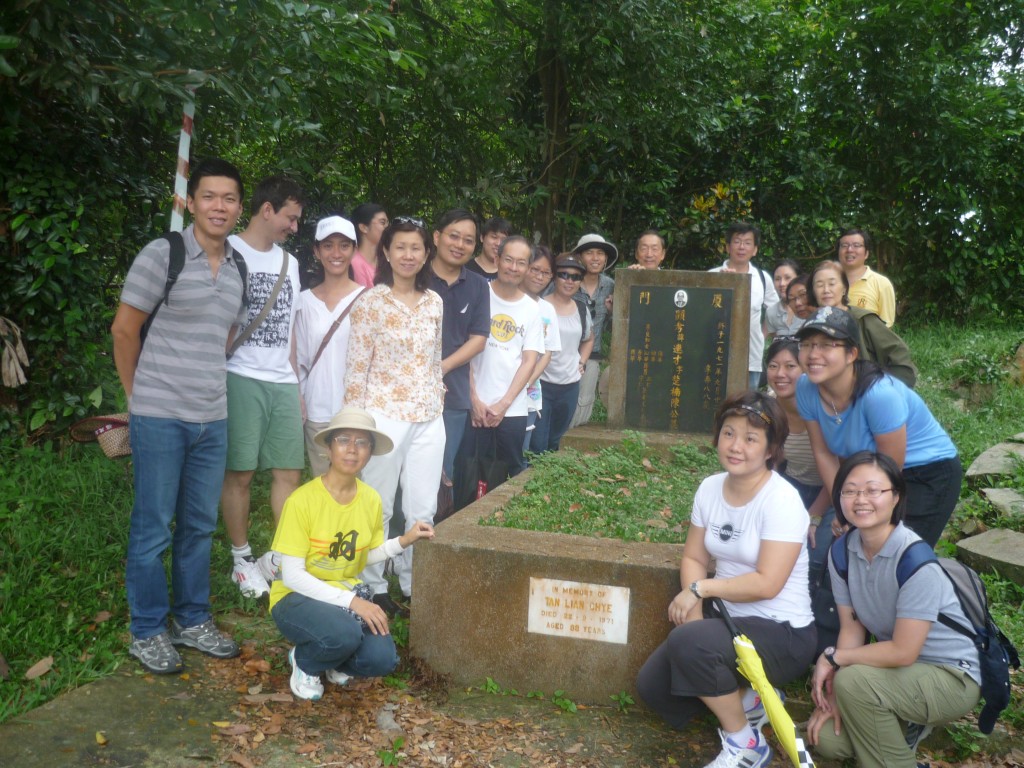
Tan Chor Nam, aka as Tan Lian Chye last and most significant stop for the docents. His photo with Sun Yat Sen is the first one which greets visitors at Sun Yat Sen Memorial Hall
The docents felt that visiting the TMH tombs helped to bring these pioneers alive and they have more stories to share when they next guide at the Sun Yat Sen Memorial Hall.
compiled by Catherine Lim
Peter Pak and Andrew guiding.
We will take a stroll around Hill 3. We will be visiting the biggest tomb, and the colourful Sikh guards. You will hear stories about the heritage as well as the nature that makes this a magical place
==========================
Meeting Place: Under the large and beautiful, and possibly endangered, rain tree, at the Roundabout.
After the main gate, go ahead another twenty metres, to the right of the SLA office
For information on how to get there and handy tips please visit
http://bukitbrown.com/
==========================
Registration:
Our weekend public tours are FREE …
Optimally the group size is 30 participants (15 individuals/guide).
Please click ‘Join’ on the FB event page to let us know you are coming, how many pax are turning up, or just meet us at the starting point at 9am. We meet there rain or shine.
==========================
The tour:
The Bukit Brown area is about 233 hectares in extent, bordered by Lornie Road, Thomson Road and the Pan-Island Expressway. It lies just to the south of the Central Catchment Forest, being separated from it by Lornie Road and includes Singapore’s only Chinese Municipal Cemetery. With more than 100,000 graves, Bukit Brown is also one of the largest Chinese cemeteries outside of China.
Don’t forget to bask in the peaceful surrounds, and also chat with your guides and make friends with other participants. We are amateurs and volunteers, but we are passionate and serious about what we do at Bukit Brown, and we encourage sharing of knowledge.
Here is a map of the grounds:
http://bukitbrown.com/
==========================
Please take note:
1. We will be walking mainly on paved roads. But there are hill treks so dress appropriately, especially your footwear.
2. Wear light breathable clothing. Long pants and long sleeves if you are prone to insect bites or sunburn. Bring sunblock and natural insect repellent.
3. Wear comfortable non-slip shoes as safety is important. Walking sticks are recommended.
4. Do read up on Bukit Brown before going so you have a better understanding of the place (e.g. BukitBrown.com)
5. Do bring water, light snacks, poncho/umbrella, sunhat and waterproof your electronics.
6. Please go to the toilet before coming. There are NO facilities anywhere there or nearby.
==========================
How to get there by MRT / Bus:
Bus services available: 52, 74, 93, 157, 165, 852, 855.
From North: Go to Marymount MRT and walk to bus-stop #53019 along Upper Thomson Road. Take Buses 52, 74, 165, 852, 855
Alight 6 stops later at bus-stop, #41149, opposite Singapore Island Country Club (SICC), Adam Road. Walk towards Sime Road in the direction of Kheam Hock Road until you see Lorong Halwa.
From South: Go to Botanic Gardens MRT and walk to bus-stop #41121 at Adam Road, in front of Singapore Bible College. Take Buses 74, 93, 157, 165, 852, 855. Alight 2 stops later at bus-stop, #41141, just before Singapore Island Country Club (SICC), Adam Road. Cross the bridge, walk towards Sime Road, follow the road until you see Lorong Halwa.
By car:
Turn in from Lornie Road, to Sime Road. Then, turn left into Lorong Halwa.
Parking space available at the largish paved area near the cemetery gates.
The Origins, Traditions and Beliefs of what today has become popularly known as “The Hungry Ghost Festival”
by Victor Yue
Between the ancient Chinese characters and the modern English vocabulary, there seems to be a big mis-match as to what the festival is about. But for ease of communication, some terms that seem to be closest in translation would it seems, have to do. In some cases, such as events, more exciting phrases were coined in Chinese and explains I believe how we have arrived at the name The Hungry Ghost Festival.
The Origins
It is said that although the 7th Month event is an age old tradition and custom from ancient times marked during the 7th lunar month, the term “Gui Jie” meaning Ghost Festival did not appear until the Ming Dynasty. I am curious as to when the word “Hungry” was added into the Ghost Festival, making it the Hungry Ghost Festival. Indeed this additional adjective does much to fire up the imagination of the more impressionable young and those unfamiliar with the 7th Month event.
Older Chinese, simply call it Chit Gue (7th month in Hokkien), Por Tor (Pudu in Mandarin) or Tiong Guan Huay (Zhong Yuan Jie) which is probably more official as these are the words used in the posters and banners put up during this time.
As with most age old traditions, it’s difficult to separate the practice, beliefs and the myths. We tend to embrace them together and it becomes a colourful, cultural potpourri
How is it “celebrated”?
The 7th Month in Singapore means different things to different people. To believers and those who have “the third eye”, it is a month when the entities of the nether world come a calling. “Don’t go out late, Don’t go swimming” would be the warning from Grandma. The grandchildren would dutifully say “yes” and do exactly the opposite! And should anything untoward happen, Grandma would say “I told you so!” and follow up with making reparations to ask the “invisible” for forgiveness.
For the Hokkiens and Teochews (and probably for other dialect groups as well), on the first night of the 7th month, they would be lining up candles and joss-sticks to “welcome” the visitors (who might include their ancestors) offering them food and burning joss-papers (money). They do the same on the last day of the 7th month to send them off. In between, on the 15th day, they would also d0 another similar round of offerings. For the Cantonese, I understand that they do it on the 14th night of the 7th month.
A few days before the arrival of the 7th month, the organisers of the neighbourhood’s 7th Month prayers – officially called “Celebrating Zhong Yuan Jie” – will set up make-shift altar tables at a suitable place, usually close to a lift landing or a corner of an HDB block Some HDB block or blocks may have more than one group of Zhong Yuan Jie organisers. Most of these organisers would have continued since the days when the residents were from a different neighbourhood. They tended to follow the migration of many of the residents from the old houses (kampong /pre-war homes) to their new homes in housing estates.
Back in the good ole days….
In the old days (circa 1950s), this event lasting between one and three days in any neighbourhood was one that the kids look forward to. Most families would subscribe to one of the Zhong Yuan Jie (or Por Tor in Hokkien) having paid a dollar a month. During the Por Tor, the organisers would have the goodies as offerings to the Por Tor Gong (the Tai Shi Ya or Da Shi Ya) before giving each subscribing household a pail of these goodies.
Apart from the 7 essentials (柴米油鹽醬醋茶- charcoal, rice, oil, salt, soya sauce, vinegar and tea – what’s needed in a typical kitchen of the old days ) there might be half a braised duck or chicken, something that was a luxury in the 50s for most families. There would also be an abundance of fruits – from Rambutans to Buah Langsat to Buah Duku.
For children, it was like carnival time. Street wayangs – about the only open air entertainment and free to boot of those times, would spring up. They were set up so skilfully within half a day using only mangrove poles tied together by soaked split rattan, and wooden planks for the flooring. I remember taking a stool from my house to “chope” (reserve) a place to watch. The afternoon show was from 2pm to 5 pm and evening from 8pm to midnight. Food was close at hand. Hawkers would encircle the wayang stage and even underneath the raised stage, selling food such as oh-jian (the traditional barnacles in fried sweet potato flour with eggs ), traditional desserts (offerings from red bean soups to sweet potatoes to tau suan and bubur telegu), fried kway teow, shellfish (cockles and siput) and much, much more. And when I was bored with the wayang I would take a turn at the games station and try my luck at tikam-tikam – just folded paper that for 5 centsa pick, you get a a shot at winning a prize of some cheap toy or sweets. I hardly ever won anything.
In the streets of Chinatown
In the Chinatown of old, each house would, in step with the organising communities for Por Tor, set up their altar tables outside their house to make offerings. As the majority of such houses had multiple tenants, the landlord would lead in organising the prayers. The narrow streets meant street wayangs were allocated specific dates for the Por Tor. One would be able to see the offerings from the beginning to the end of the street, with the triangular flags stuck into the food/fruits fluttering in the wind.
Sometimes, the community prayer ends up with a grand dinner where items are auctioned off and money raised – the collection of which could take up to a year – for the next Por Tor. The funds help to pay for not only the event but also the food baskets.
Enter the getai …
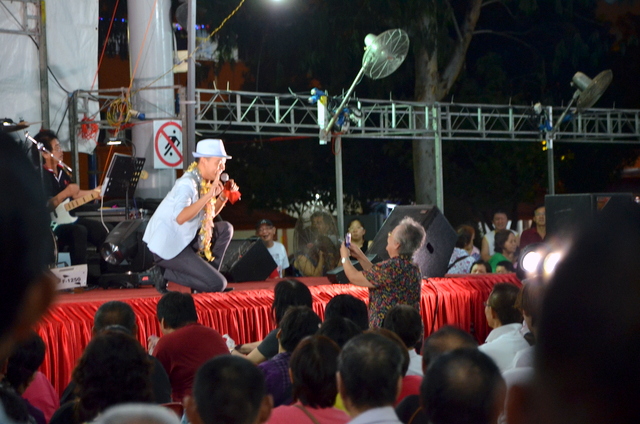
Getais came on the scene in theearly 60’s and overtook the wayangs in popularity (photo by Victor Yue)
Getai probably started in the 60s and quickly held the crowd captive. But long before their entry, some street wayangs had some of their actors/actresses singing before the opera started, as a warm up act, but it did not develop further. It took off probably following the hey day of the wildly popular Wang Sar and Yueh Fong. The duo took Singapore by storm and everyone knew the exclamation “Wah Lao”. During that time, there were also the Getai entertainment establishments where one could pay for entrance and get a drink to watch. The last one, similar to those in Taiwan, to my memory must the one at the former Wisma Atria, which I would go with my classmates each Chinese New Year eve.
In Chinese temples
In the Chinese Temples, the offering on the 15th of the 7th month was to Di Guan, one of the three Officials of the three realms – Tian (Heavens): celebrated on 15th of 1st Lunar Month), Di (Earth): celebrated on 15th of 7th Lunar Month and Shui (Water): celebrated on 15th of the 10th Lunar Month.
According to Taoist beliefs, praying to Di Guan is to ask for elimination of sins and debts. It is from this occasion of praying to the Di Guan or Di Yuan that the world of Zhong Yuan Jie came about.
Family….
For the family, 7th month is also a time for them to remember their ancestors. During the old days, each family, would have their ancestral altar at home. For the Hokkiens it would usually be placed next to another altar dedicated to Tua Pek Kong. For their most recently departed – a parent or grandparent – the family, usually the grandma or mother would prepare the offerings. The departed and the ancestors further down the line would be’invited” to come and partake of the offering. For us kids, it was also another occasion we waited for, for it meant that we could have more elaborate dishes that we would not get otherwise. Chinese New Year and 7th Month are the two major occasions that children look forward to and our poor parents would dread it as they would need to find money to cook up at least something worthy for their ancestors.
Today, many would have have moved the family ancestral tablets to the temples and so, offerings would be at the temples. Food offering’s also became simplified with fast food that could be the packed from chicken rice to Kentucky Fried Chicken.
7th Month represents a spectrum of Chinese culture, of beliefs, tradition and customs, with variations for different dialect groups, and in some instances also influenced by the practices from ancestral place of origin in China. We remember our ancestors; we think about the wandering souls (those whom the descendants have forgotten or who may no longer have living descendants); we seek pardons from the Official of the Earth Realm. This we do, to preserve our unique culture which also evolves with the times.
Victor Yue is Taoist and spends much of his time researching and documenting Chinese religious practices and rituals.
Here is a video he took on a auction on Pulau Ubin for the Hungry Ghost Festival
Here is another of Victor’s video on “Breaking Hell’s Gates” – a rare ritual conducted only once every 5 years at Peck San Theng Temple in Bishan
At Bukit Brown during the 7th month, tour groups also encounter evidence of rituals and offerings
By Eugene Tay
Eugene helms the movement “We support the Green Corridor” and is one of the partners of All Things Bukit Brown.
The Green Corridor is a former railway while Bukit Brown is a cemetery, so different yet so similar. The Green Corridor and Bukit Brown both connects the past and future, and both involves heritage and the environment. I hope that all of you can support the preservation of Bukit Brown, just as you have actively supported The Green Corridor so far.
I supported The Green Corridor proposal by NSS because I feel that it would improve Singapore’s long-term resilience. The biggest threat to Singapore is apathy, and when Singaporeans do not feel a sense of belonging and are not bothered with what goes on here, then Singapore is in trouble.
For Singapore to survive and prosper in the long term, it is necessary to have more opportunities in preserving our shared memories and creating our shared vision. And keeping the railway lands as a Green Corridor is one opportunity not to be wasted.
Similarly, I feel that Bukit Brown is another excellent opportunity that enables Singaporeans to feel they belong here by remembering our past and creating our future.
Remembering Our Past
Bukit Brown tells the stories of our forefathers who built Singapore, and creates opportunities for history education and discovery. The cemetery connects Singapore’s past and present, and allows us to understand that Singapore’s success is built up by our forefathers’ sweat and tears, and should not be taken for granted.
We should preserve Bukit Brown because it helps us remember our past and keeps us rooted to Singapore.
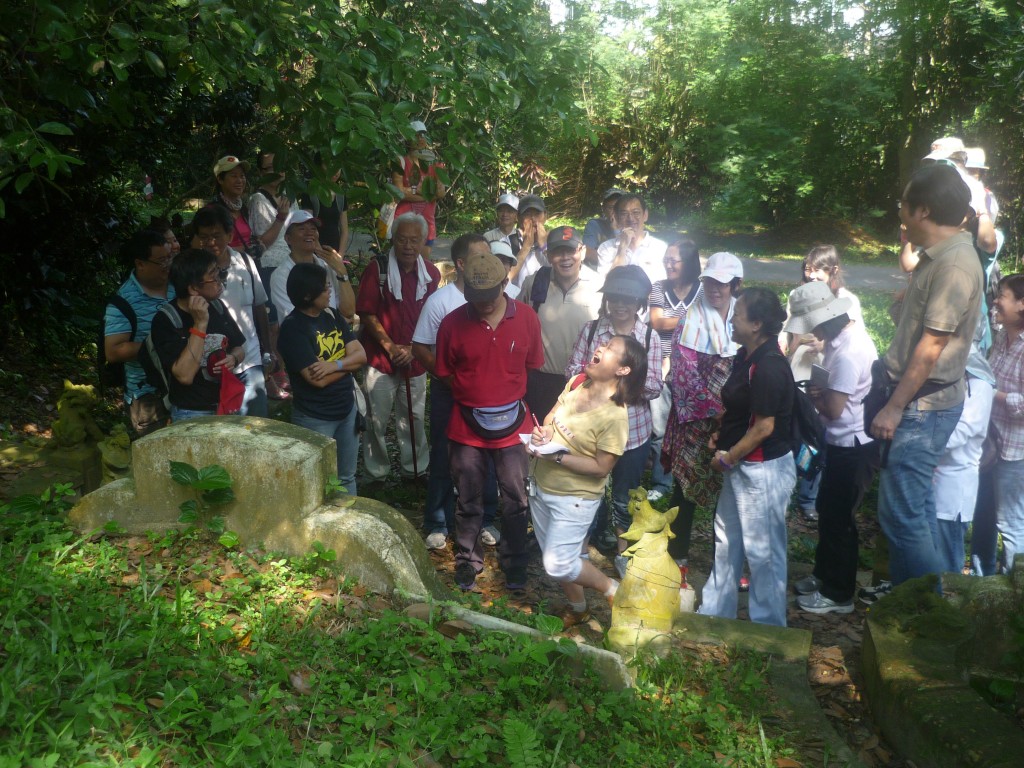
Intense interest in the historical tombs and shared camaraderie on public tours (photo Catherine Lim)
Creating Our Future
Bukit Brown presents the opportunity for transforming the cemetery into a world-class living outdoor museum or heritage park. If this transformation adopts a bottom-up approach and with stakeholder engagement, it would allow us to come together, plan and work towards a future Singapore where heritage, nature and our economic needs can co-exist.
We should preserve Bukit Brown because it enables us to work together and build bonds and resilience, and to create a space where our children and their children can enjoy and be proud of.
Support Bukit Brown
Singapore is a young nation and needs more common spaces like The Green Corridor and Bukit Brown to remind us how we got here and why this is home, and to create opportunities for building our future social resilience. Support Bukit Brown, just as you have supported The Green Corridor.
Here’s what you can do:
1. Sign the petition to save Bukit Brown 100% at the SOS Bukit Brown – Save Our Singapore website.
2. Join the Heritage Singapore – Bukit Brown Cemetery Facebook Group to understand more about Bukit Brown and keep yourself updated.
3. Spread the message by sharing with your friends about Bukit Brown and urging them to sign the petition.
In the end, our society will be defined not only by what we create, but by what we refuse to destroy. – John C. Sawhill
By Eugene Tay
Snap shots of butterflies at Bukit Brown courtesy of Victor Yue and EiLeen Ong. There is a Chinese belief that butterflies at cemetery are signs ancestors are around and happy for the company.
More information on butterflies spotted in Singapore can be found by joining this group Butterflies of Singapore and Malaysia
It was the inaugural Revolutionary Tour so dubbed because the tombs visited belong to the revolutionaries of the Tong Meng Hui. They made Singapore a base to raise funds to support Sun Yat-Sen in bringing about the fall of the Qing Dynasty who ruled between the 1905 – 1911. it was popularly called the “辛亥革命” (Revolution of the Xin Hai Year) Post 1911 they continued to play a part in influencing the course of China’s history and also contributed to Singapore’s social, economic and community development.
Walter Lim led the tour conducted in Mandarin for some 36 guides from the Sun Yat Sen museum, many of whom also guide in Mandarin at the Singapore History and Peranankan Museums. He was assisted by volunteers, Yik Han and Ee Hoon. As tours went, it was one of the most engaging and lively of tours conducted at Bukit Brown, with participants sharing their insights and postulating various theories. It took nearly 5 hours to cover just under 10 tombs. There are 13 known TMH tombs and 14 tombs known to belong to Republicans – the latter was formed after TMH at Bukit Brown. Collectively both groups were part of the Reformation movement of the New China.
The following is a photo essay report with photos by Ee Hoon and captions contributed by Walter and Yik Han. Of the tombs covered 3 belong to Republicans: Khoo Seok Wan, Leow Chia Heng and See Tiong Wah . The rest are Tong Meng Hui
First stop Tay Koh Yat. At the height of his business he owned a total of 163 buses serving public transportation. He was a patriot who started and led his own self defence force of 20,000 before the onset of the Japanese Occupation of Singapore in World War 2. With a price on his head, Tay escaped to Indonesia with Tan Kah Kee on the eve of the war. After the war, Tay returned and immediately started to compile the fatalities from his volunteer force and lobbied the colonial government for the same compensation given to widows and children of servicemen who died during the war. Initially rejected, he appealed and the colonial government finally gave in. Tay next went on to form the Singapore Chinese Appeal Committee for the Japanese Massacre victims to seek justice and compensation.

The first stop is introduction by Yik Han to Tay Koh Yat, transport pioneer, war hero and Tong Meng Hui member (photo Ee Hoon )
Stop 2, destination : the tomb of 蒋玉田(Chio York Chiang) (1856-1927). He was one of the pioneer batch of Hokkien TMH member. Others were, Tan Chor Nam, Lim Keng Chew and Liew Hong Sek.
Interesting inscription of the head stone, one side has ” 时国民党老同盟独具先“ and ”为华侨界代議士尚繋後思“ The first “He is a pioneer of the Guo Min Tang with sharp foresight” the second statement on the right says that he is a “Representative of the oversea chinese righteous member, a thoughtful person”
Around the tomb of Chio York Chiang – Buried with him is his brother, in the same tomb so the names on the tomb shoulders are those of their respective children
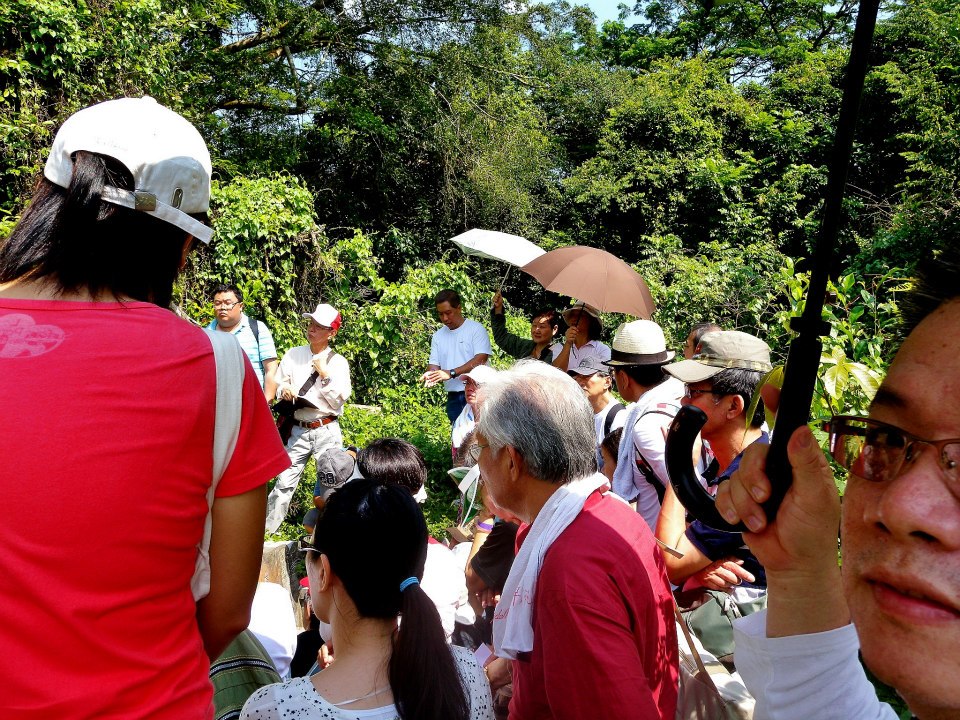
A tight squeeze around the tomb of Chio York Chiang which is unique in that it is inscribed with his and his brother’s, sons’ names on each of the tomb shoulders.(photo Ee Hoon )
Stop number 3 Tomb of Khoo Kay Hian and his third wife Lee Poh Neo, behind are his 2 older wives and watching over the cluster his mother. The first of the tombs on the tour which is staked for exhumation as it is in the way of the proposed 8 lane highway.
Stop 4 See Tiong Wah
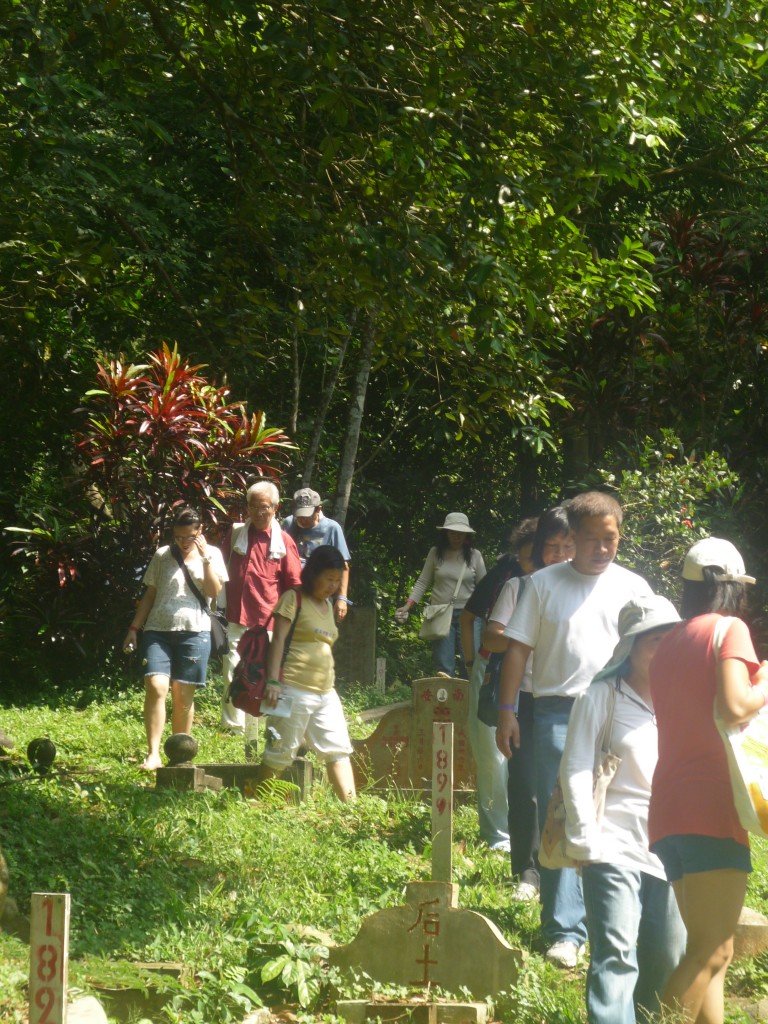
Making their way to See Tiong Wah cluster in a hill once known as See Tiong Wah hill because so many of his relations including his mother, wives and in laws are buried here. This cluster is also staked ( photo Catherine Lim)
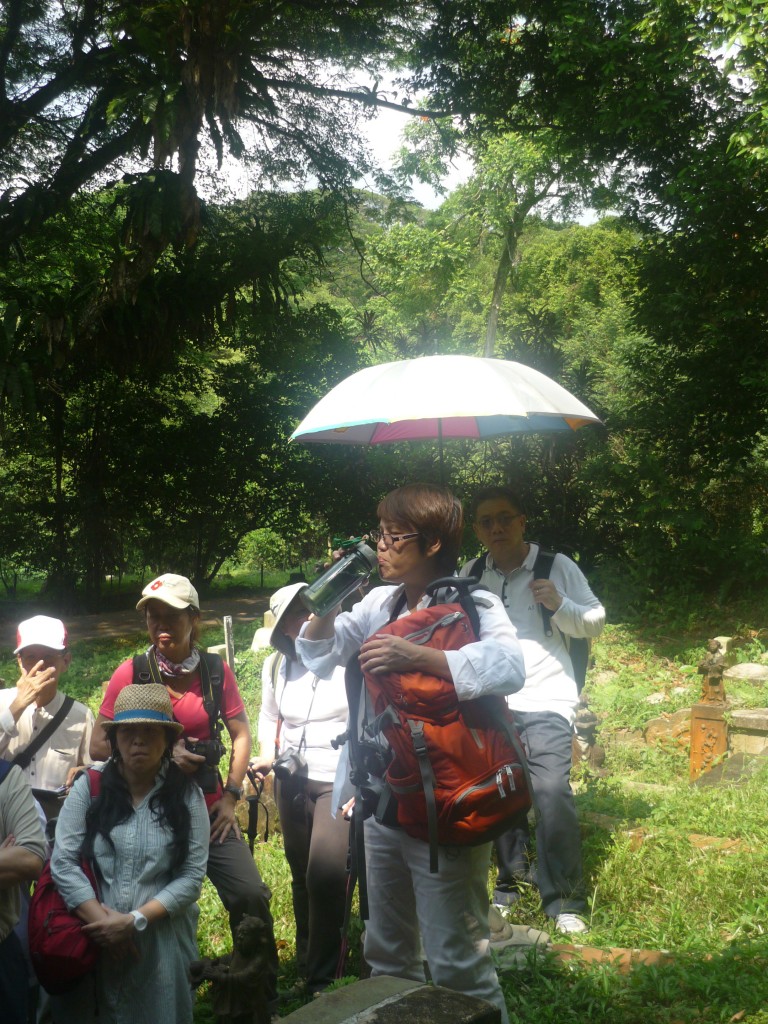
Ee Hoon takes a sip before launching into what she knows of See’s genealogy including his marriage to Khoo Seok Wan’s sister. ( photo Catherine Lim)
For more on See Tiong Wah, see here
The next stop 5, took participants up another part of Hill 2 into an overgrown tomb belonging to Boey Chuan Poh who built Wan Qing Wan

A sight of the tomb of Boey Chuan Poh, he is not a poor man but he has a really humble tomb, unmatched to his social status at that time.
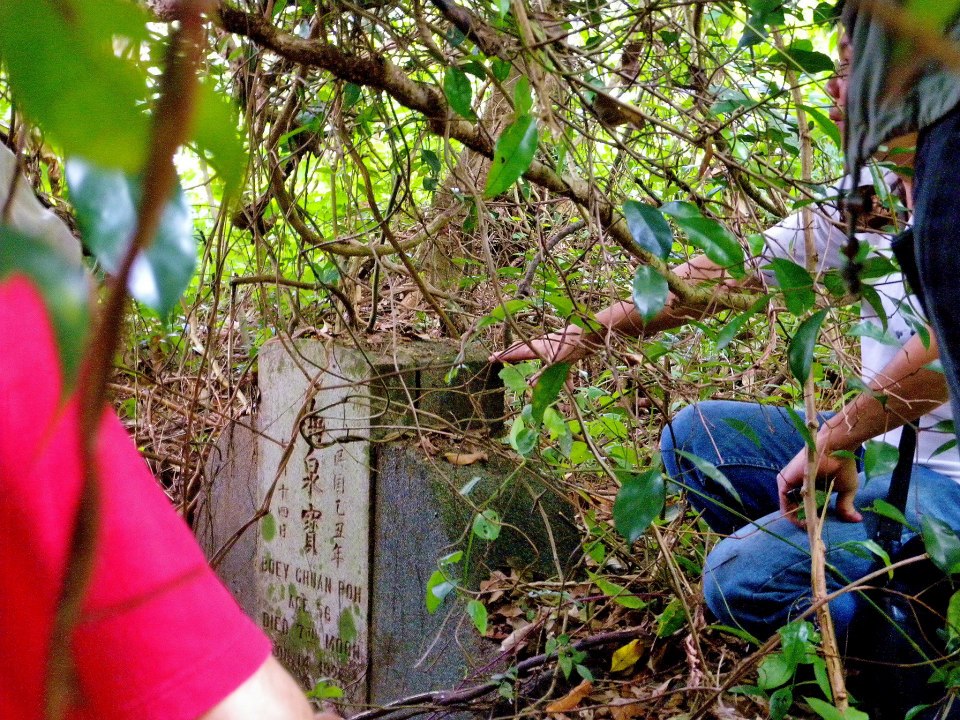
Boey barely revealed. Much ado about just who/what was Wan Qing Yuan named after, mother, wife or horse? Officially it is his mother (photo Ee Hoon)
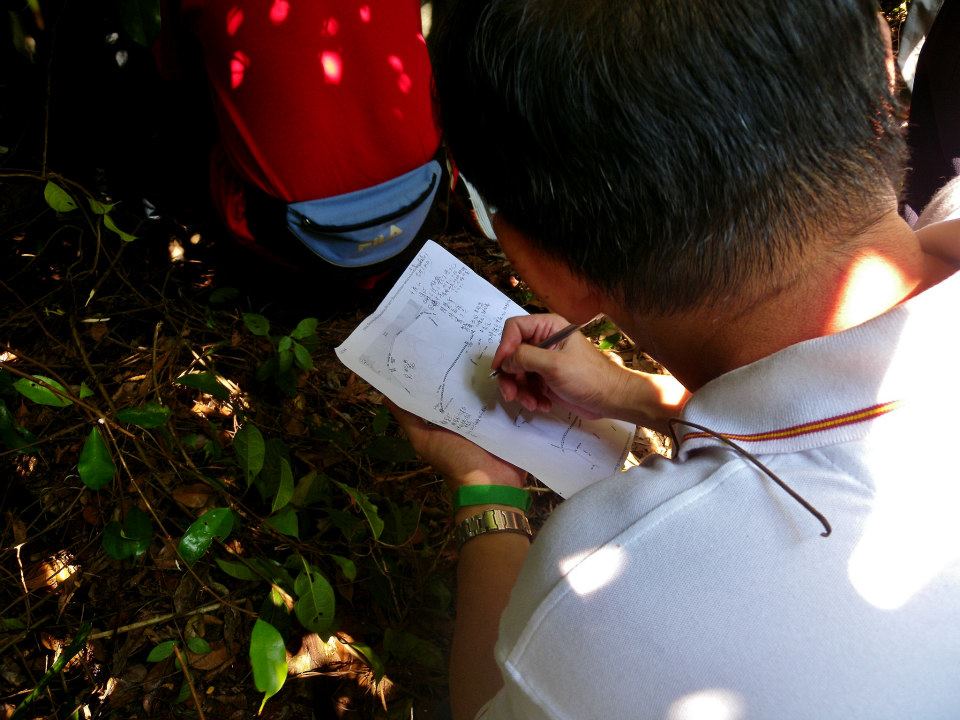
Much scribbling not just here where it was cramped but at all the tombs visited, We are expecting the tours at SYS to be much expanded as a result of this tour! (photo Ee Hoon)
Stop 6 Tan Chor Nam
Stop 7 Lim Keng Chiew

Lim was an early member of the Tongmenghui and the first secretary of its Singapore branch. He was so active in promoting the revolutionary cause that his shoe business suffered. But you say he left his footprint on the movement. He was one of the founders of the Ho San Kong Huay, a locality organisation for Hokkiens from the Ho San region in Xiamen. (Photo Ee Hoon)
Stop 8 Khoo Seok Wan

To Hill 4 and a grave marked by a hibiscus tree which always seems to be in full blossom (photo Ee Hoon)
Read about it here

A chance near where KSW tomb is located to study the LTA’s plans for he 8 lane highway and contemplate the stake tombs which are in the way, including Khoo Seok Wan’s (photo Ee Hoon)
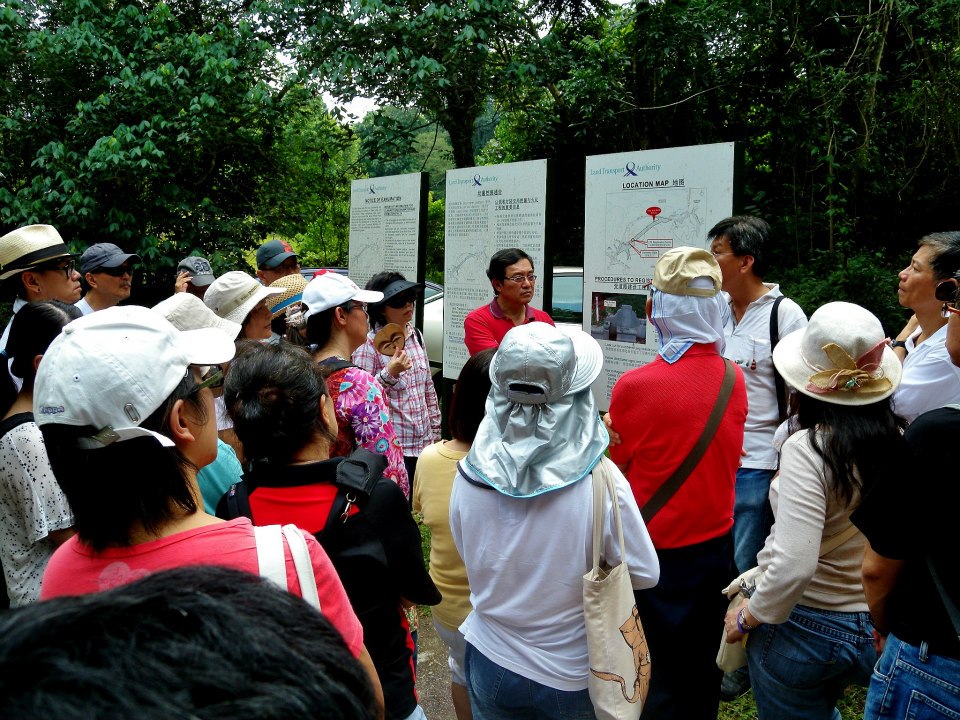
In fact when you see these boards in Hill 4, follow it, look for the hibiscus plant and it will lead you to KSW, ironic isn’t it? ( photo Ee Hoon)
Stop 9 Leow Chia Heng
For more on Leow, please click here

Nearly 5 hours later, still enough energy for one last cheer, for more tours to come (photo Ee Hoon)
Look out for Revolutionary Tours in October in English!
On Sunday 26 August, Nature Society of Singapore led a bird watching walk through Bukit Brown. Thanks to Cuifen, NSS member for compiling this album on highlights from the wal kwith additional photos from her fellow bird watcher, Leng Leng. Enjoy!
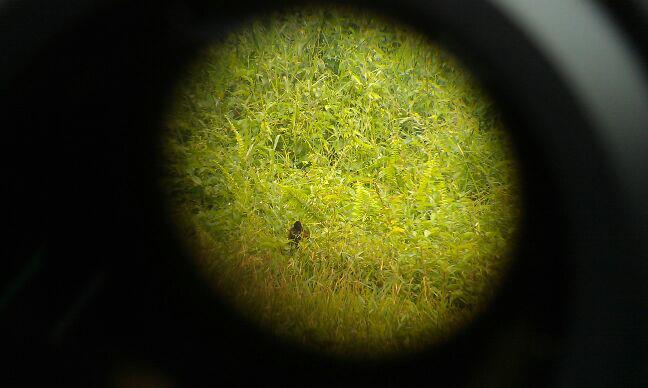
View into a scope. Lesser coucal spreading its wings, and sunbathing in the waterlogged fern area. The bird looks much clearer & closer when viewing directly into the scope (photo Cuifen)

Laced woodpecker sitting on a ‘nest’ of African tulip flowers. Photo taken by fellow bird watcher, Leng Leng.

With the Hungry Ghost festival on, maybe some pickings for the birds, after the “ghosts” have feasted of course (photo Cuifen)
RELATED POSTS:
Don’t miss this video of a nightjar and its nestling! Here’s one of woodpeckers.
Birds, Flowers and More – this shows you not only the real birds and flowers but the tomb decorations depicting birds and flowers
Here’s a look at a pangolin
FOR PREVIOUS NSS WALKS:
A Nature Ramble – this helps identify some plants at Bukit Brown
Beyond Grave Matters – this is a beautifully written commentary and event report by Rosalind Tan, whose ancestors lie at Bukit Brown

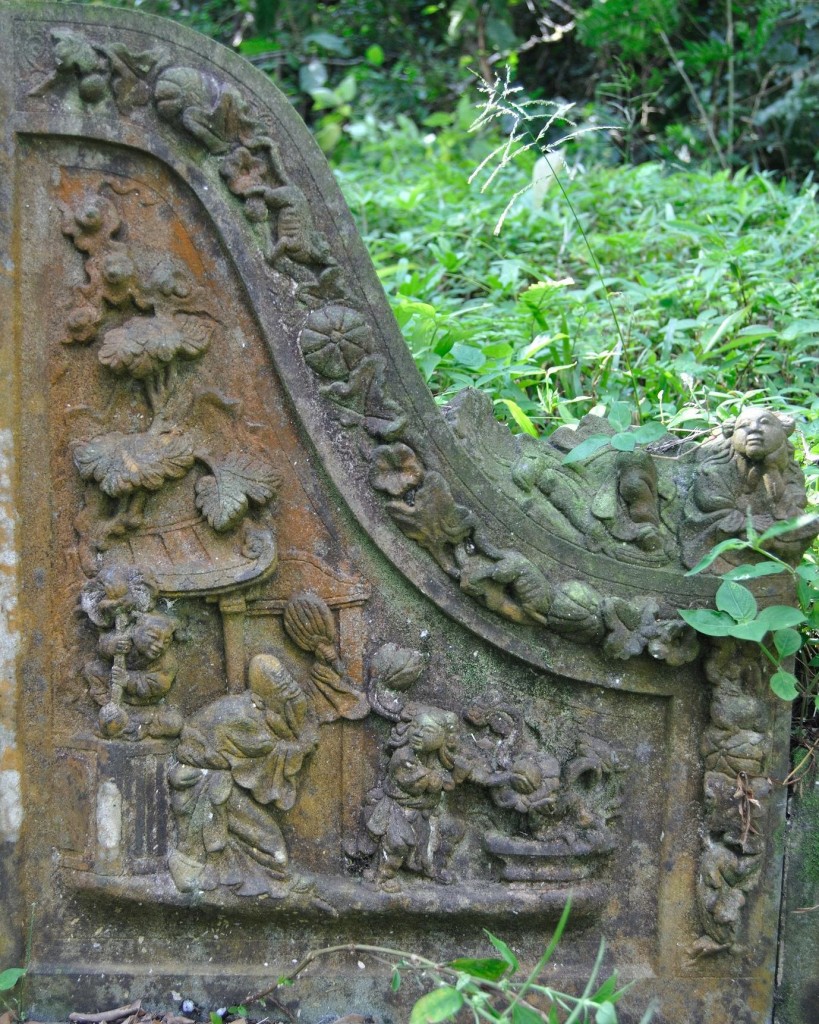

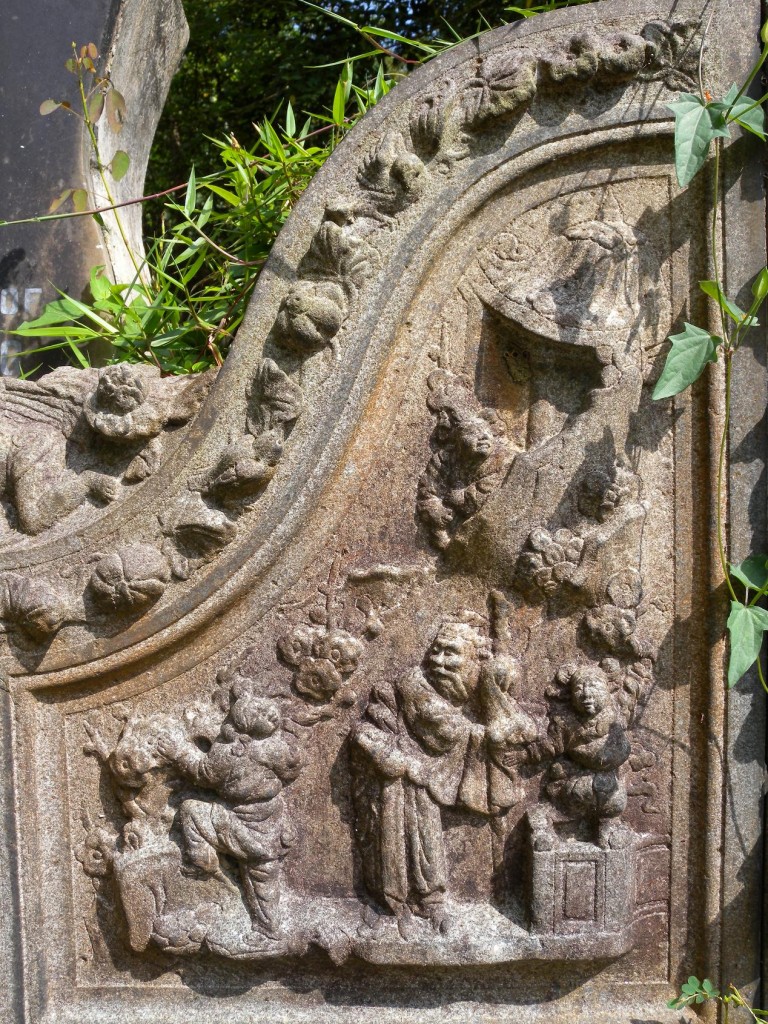

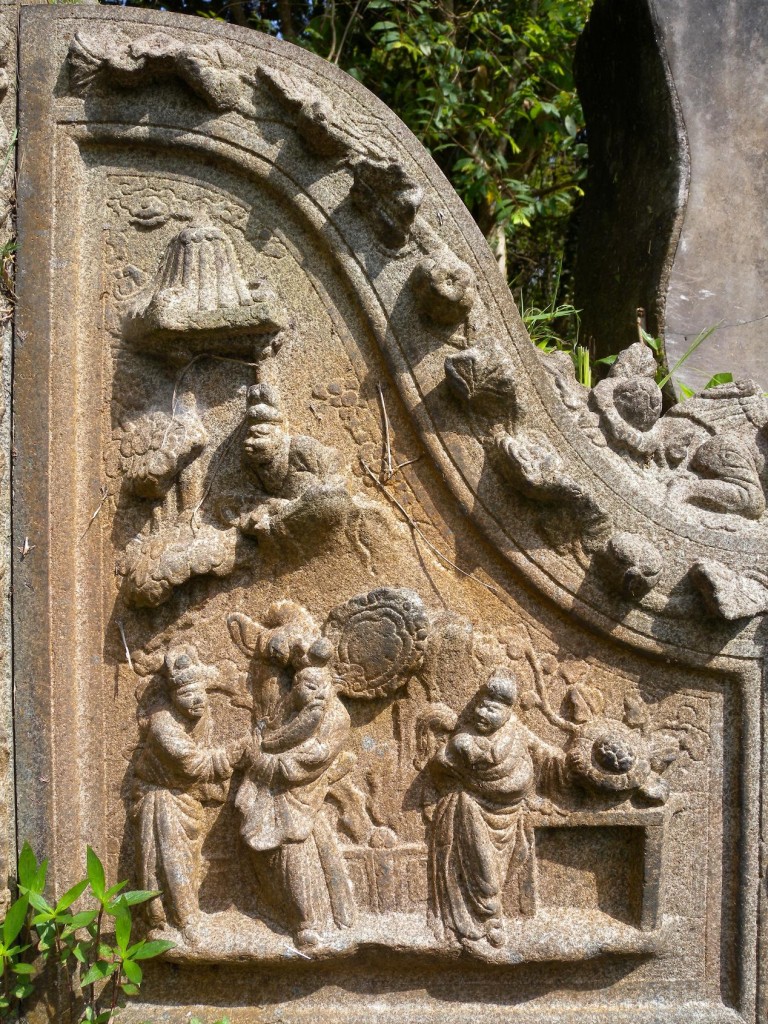


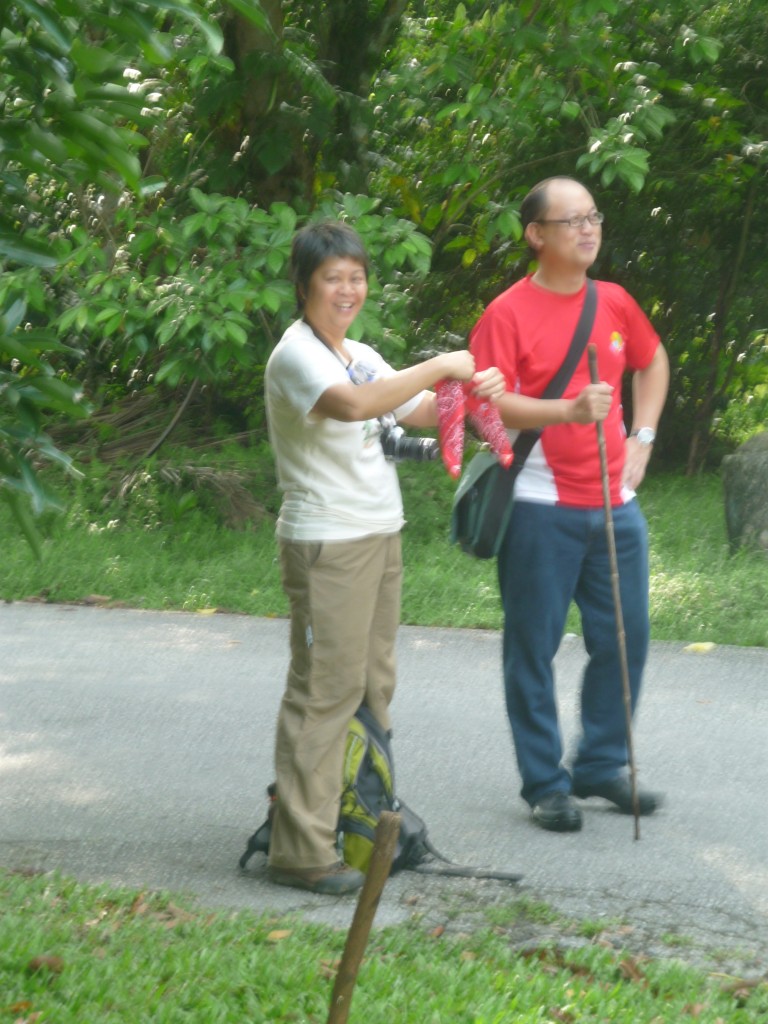

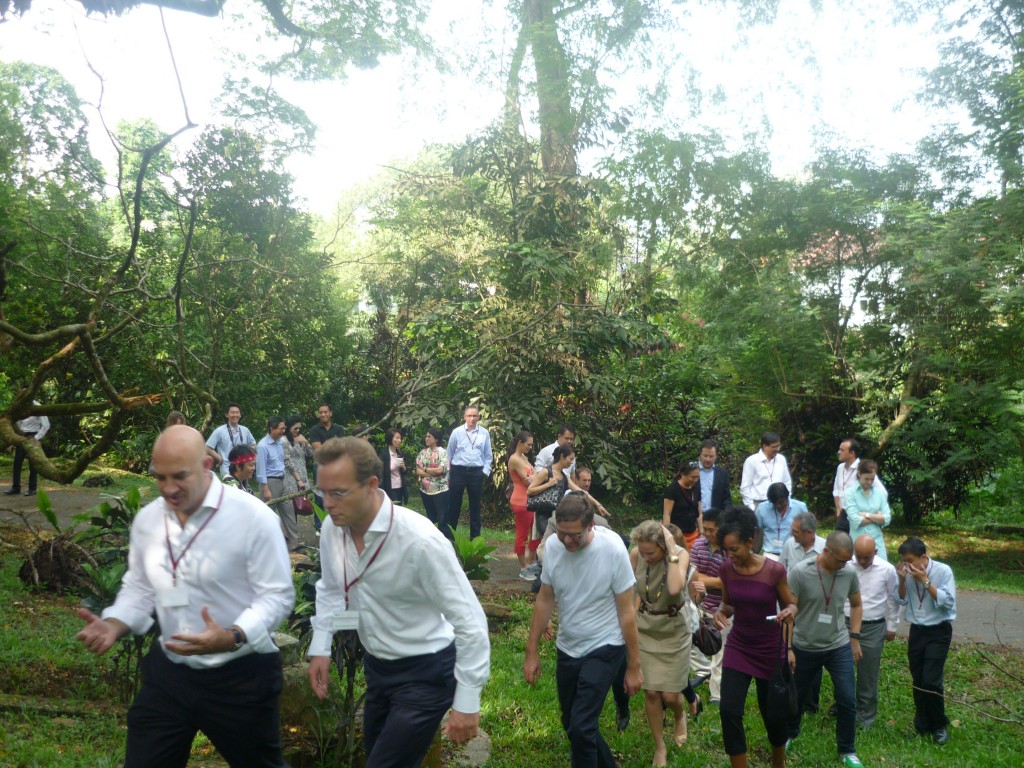
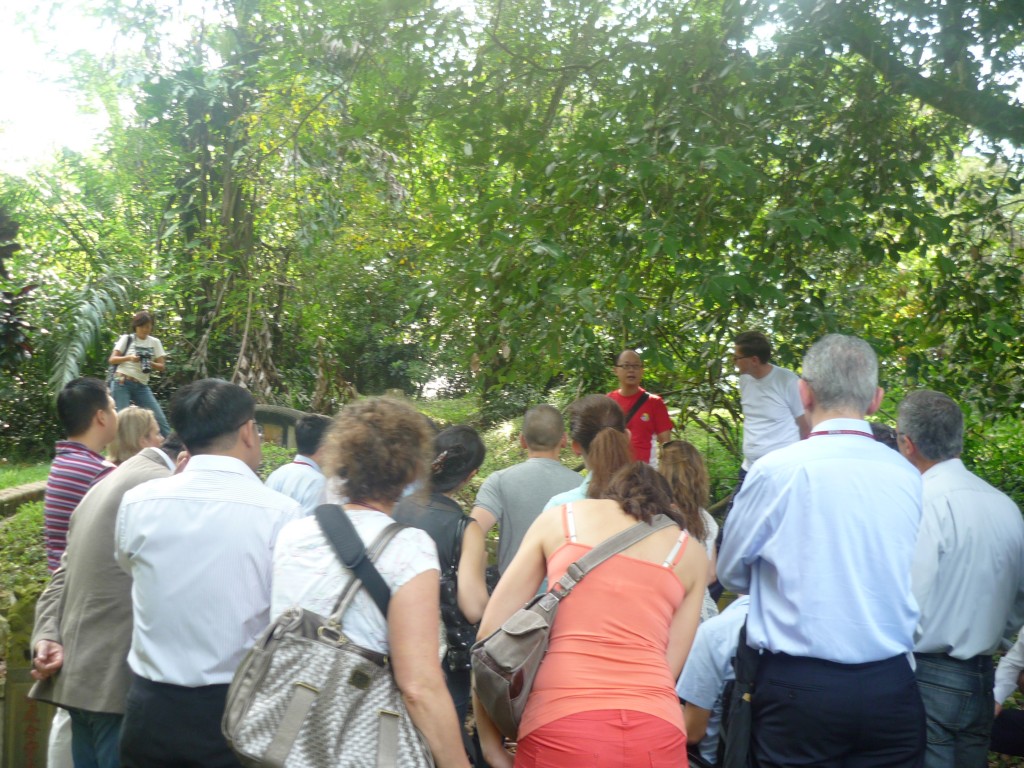


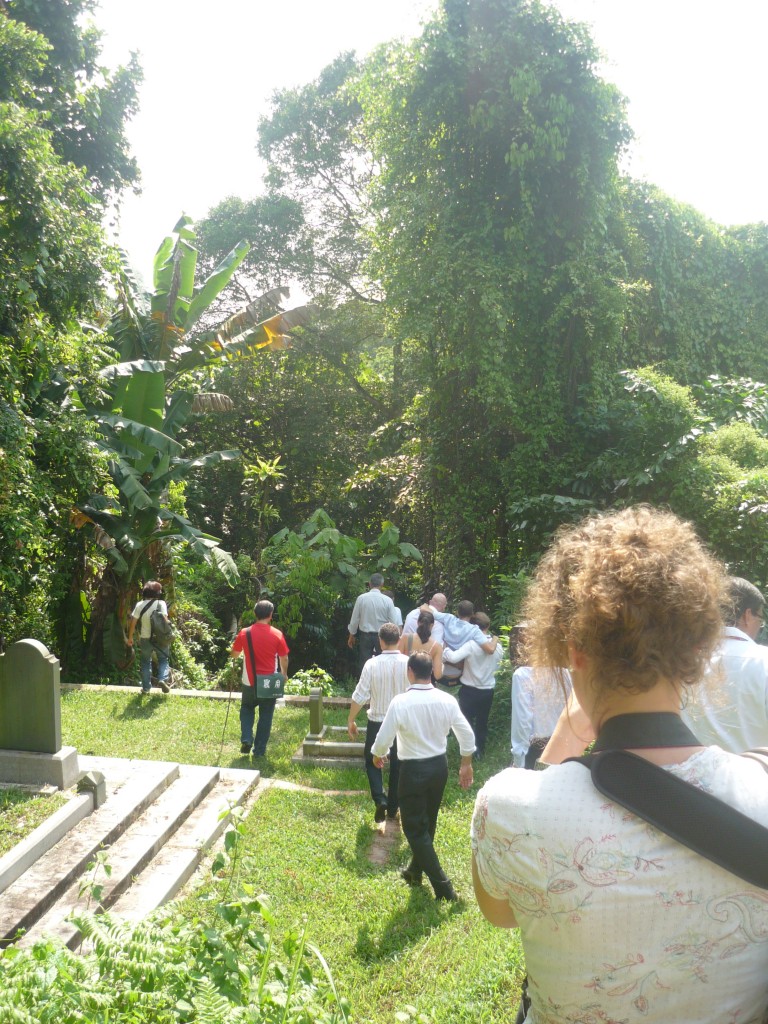

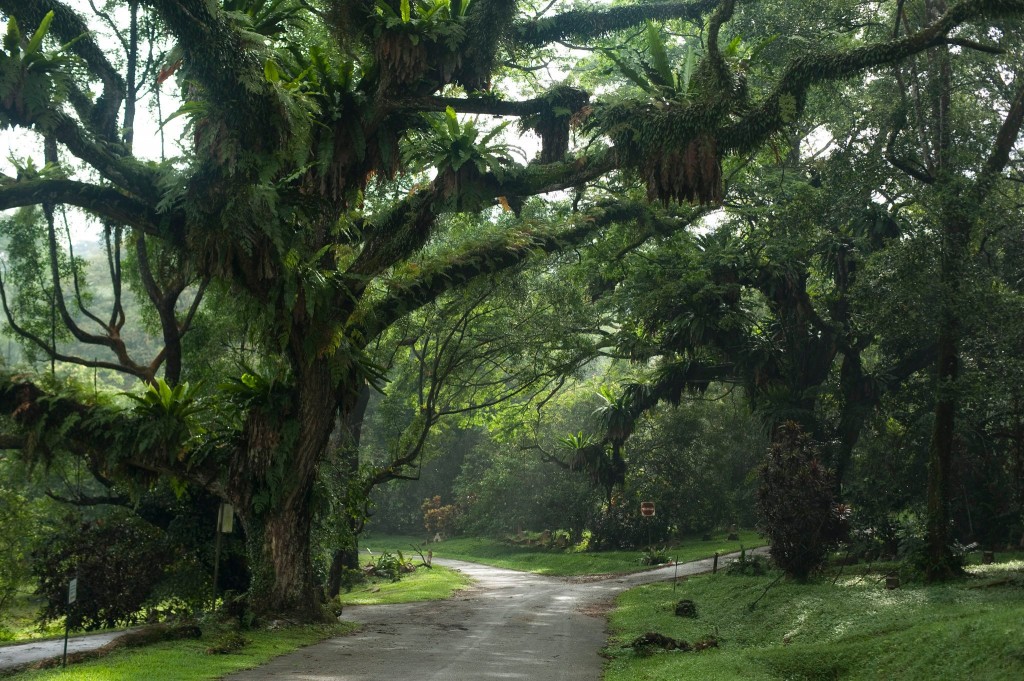
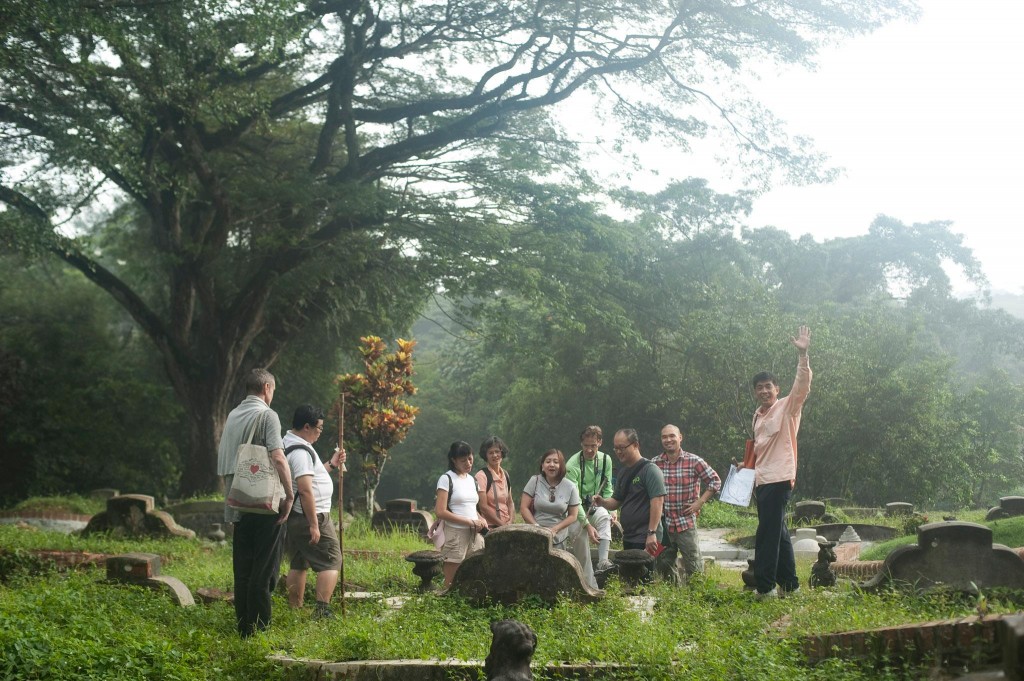
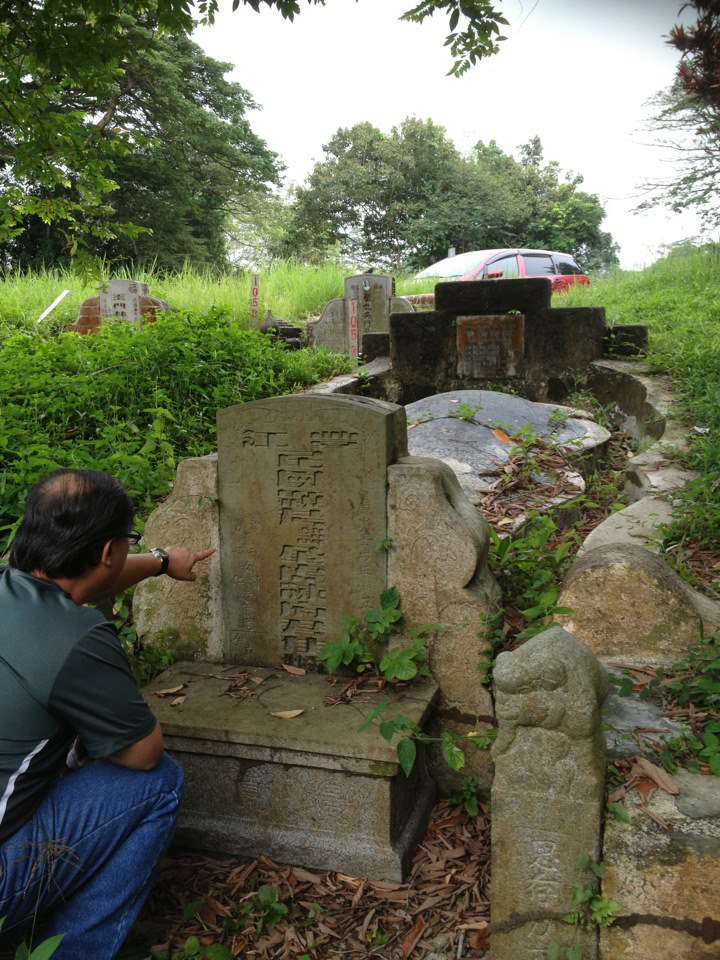
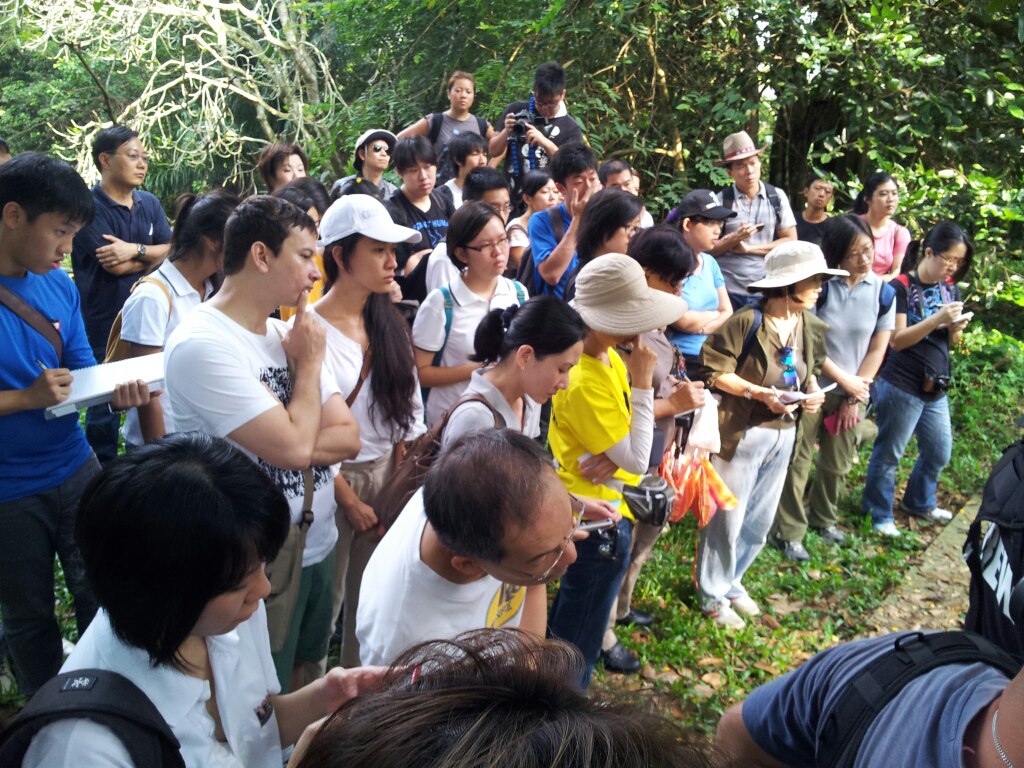

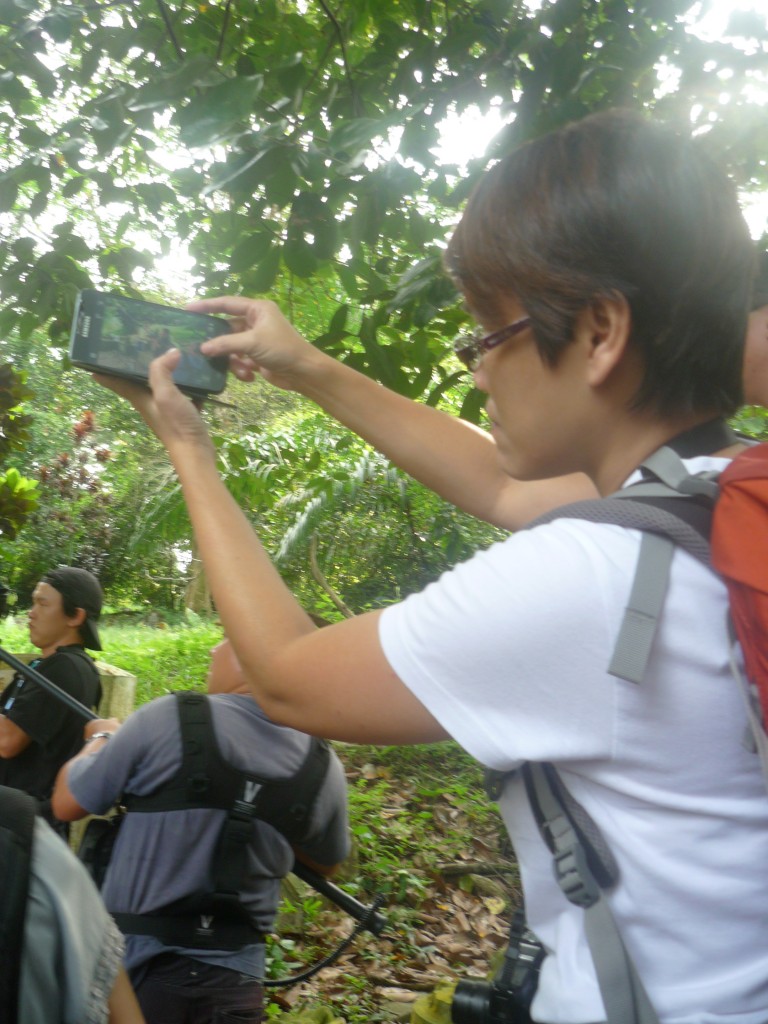
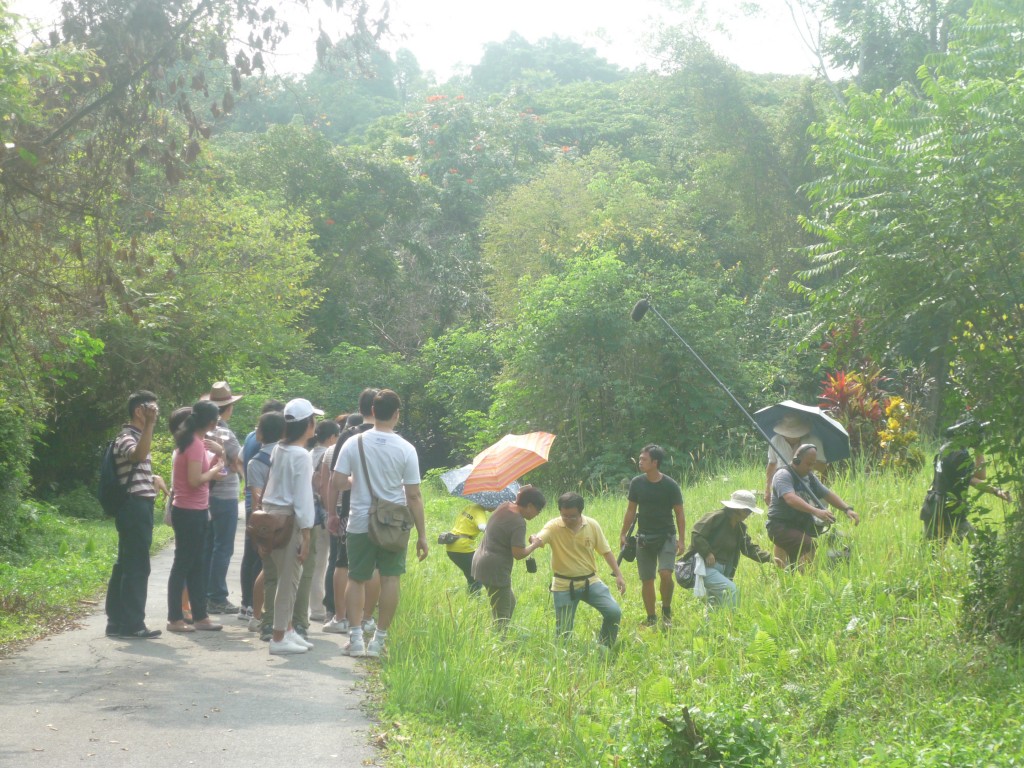

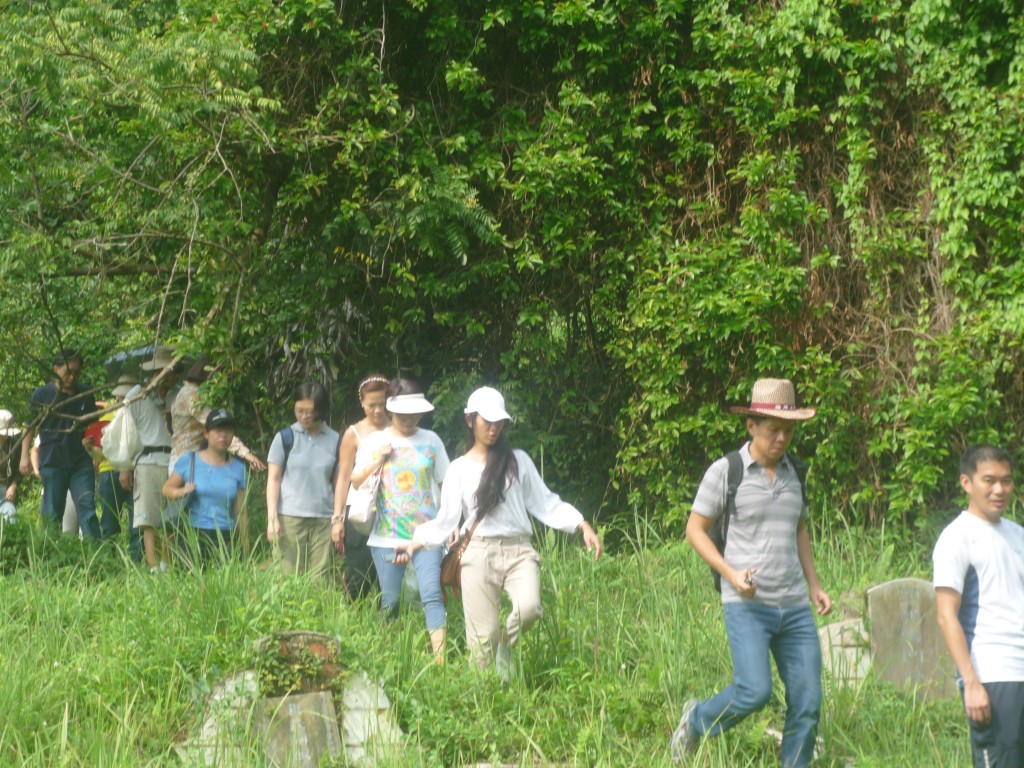
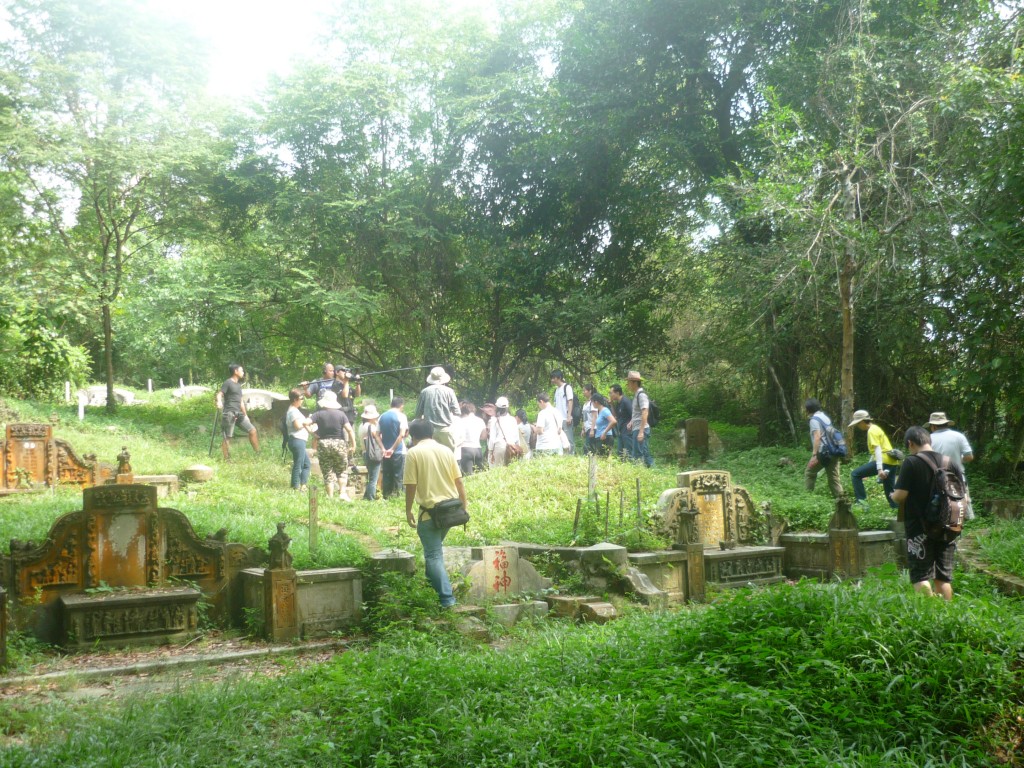
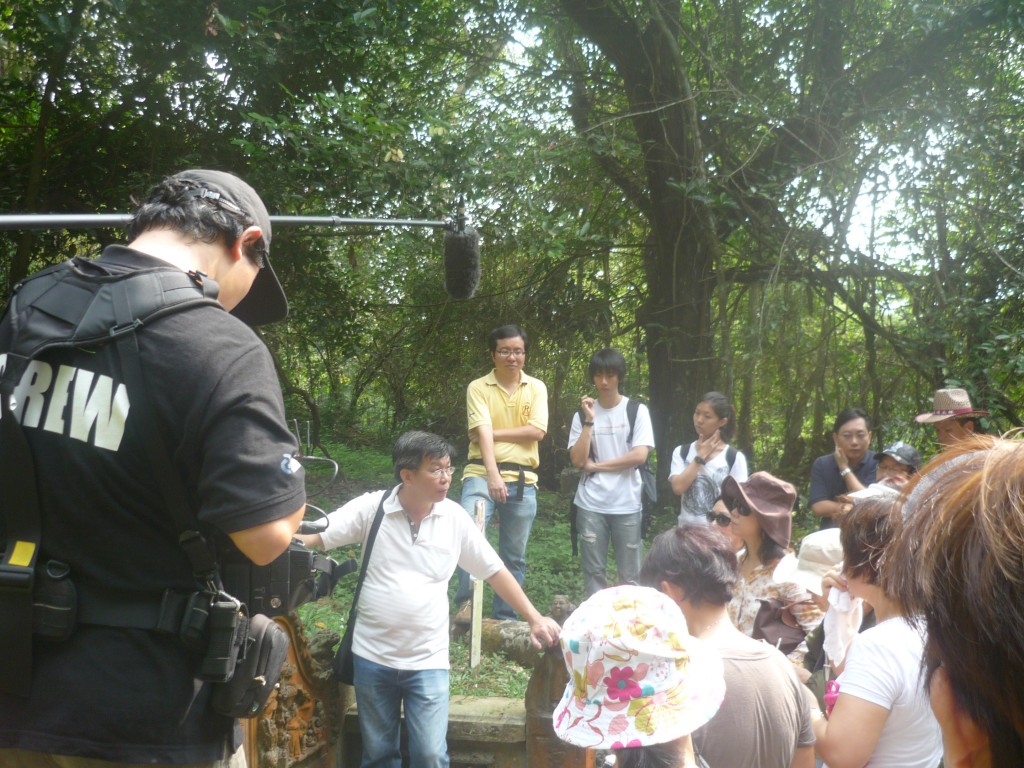


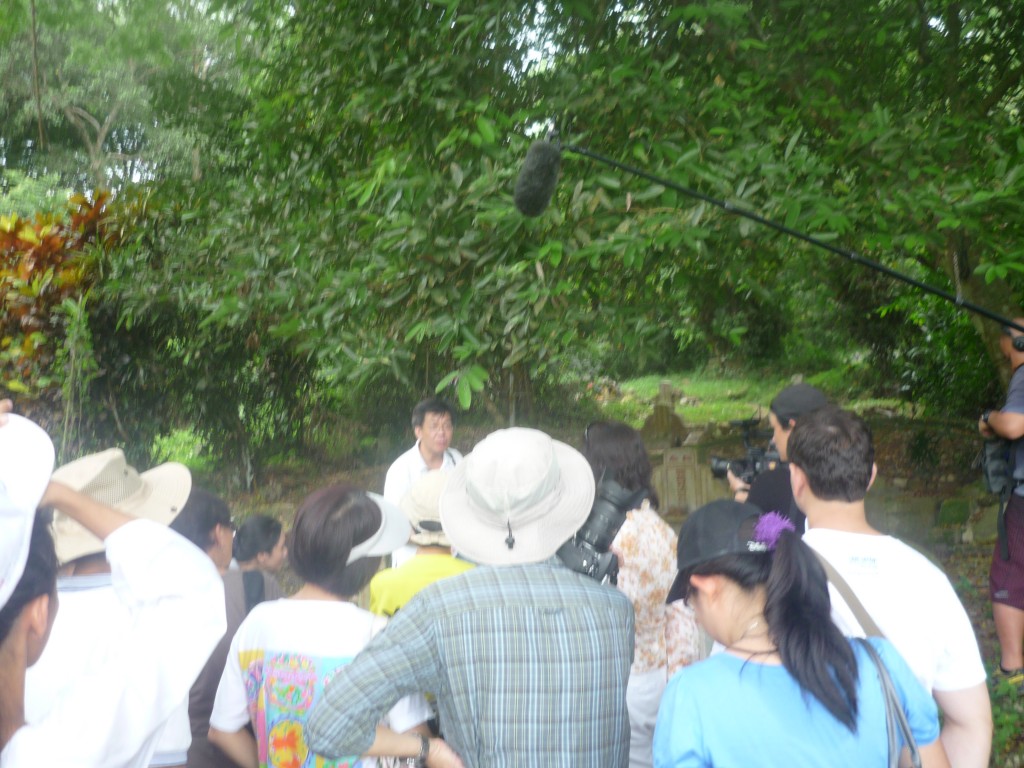



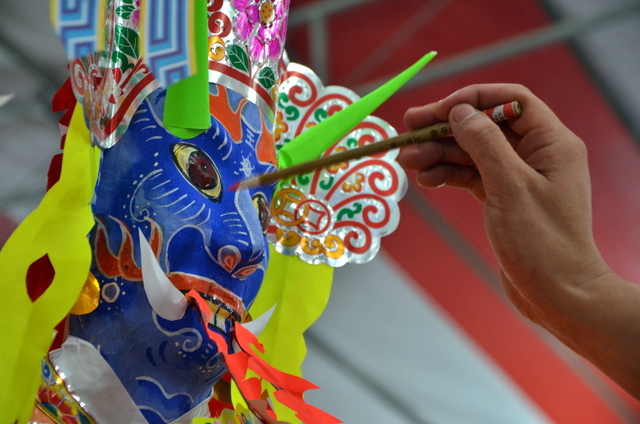
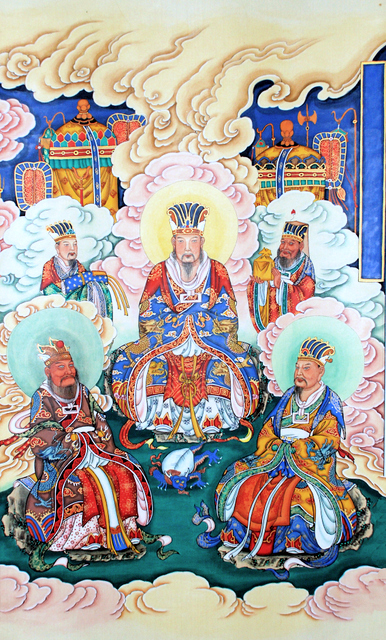

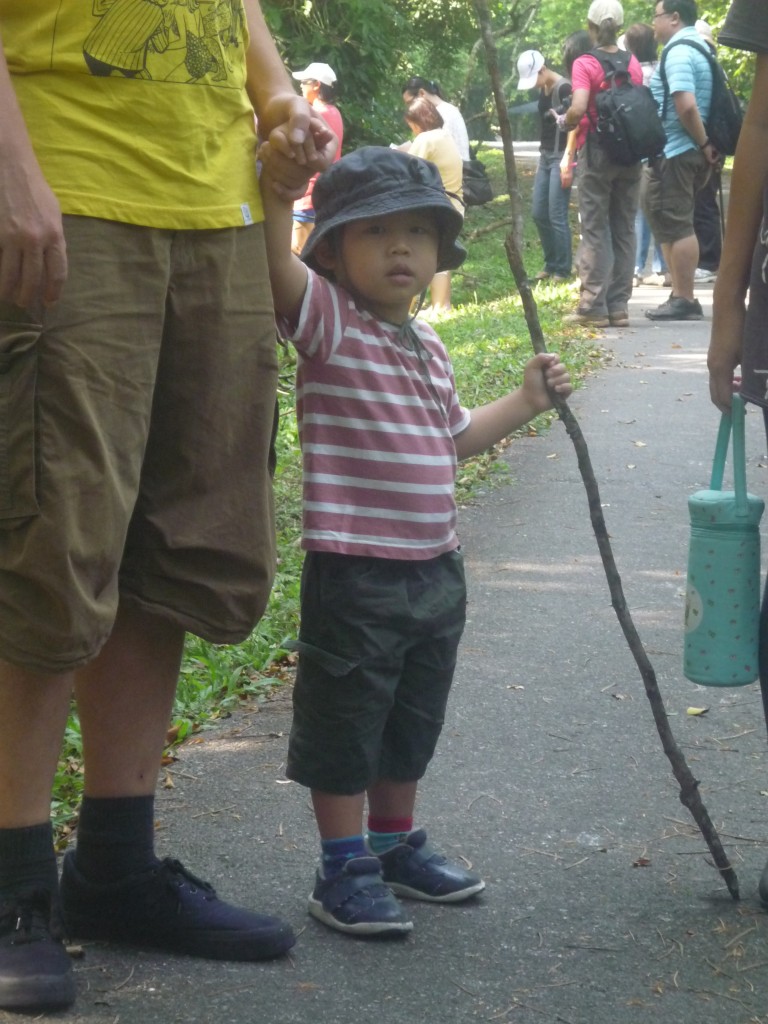
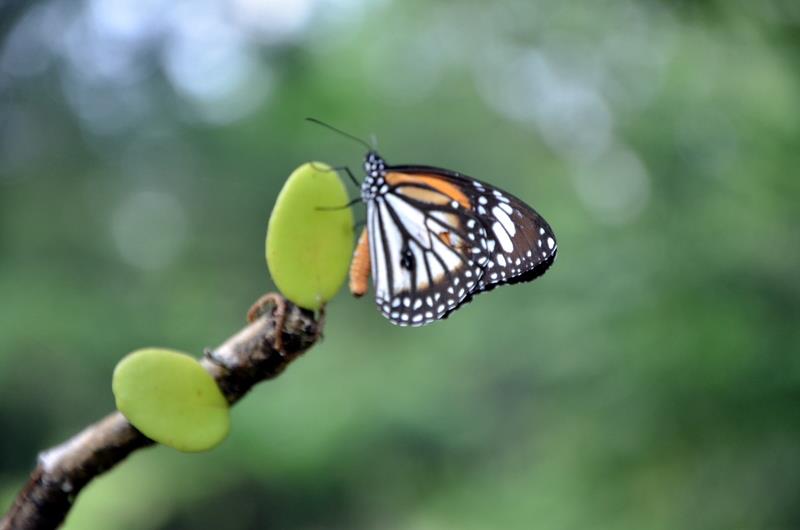


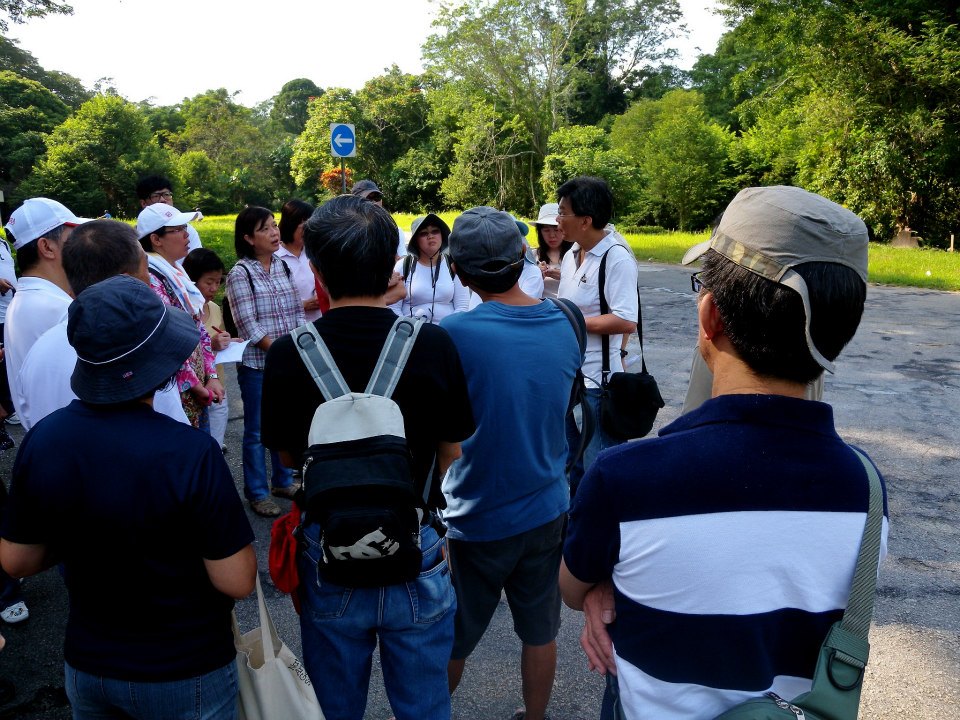
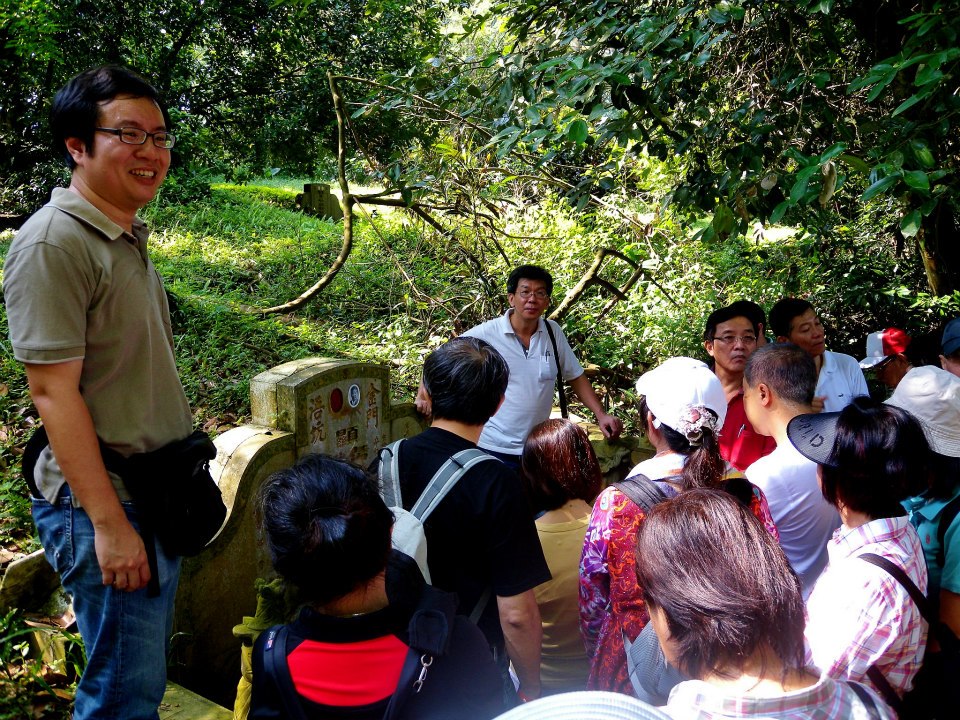
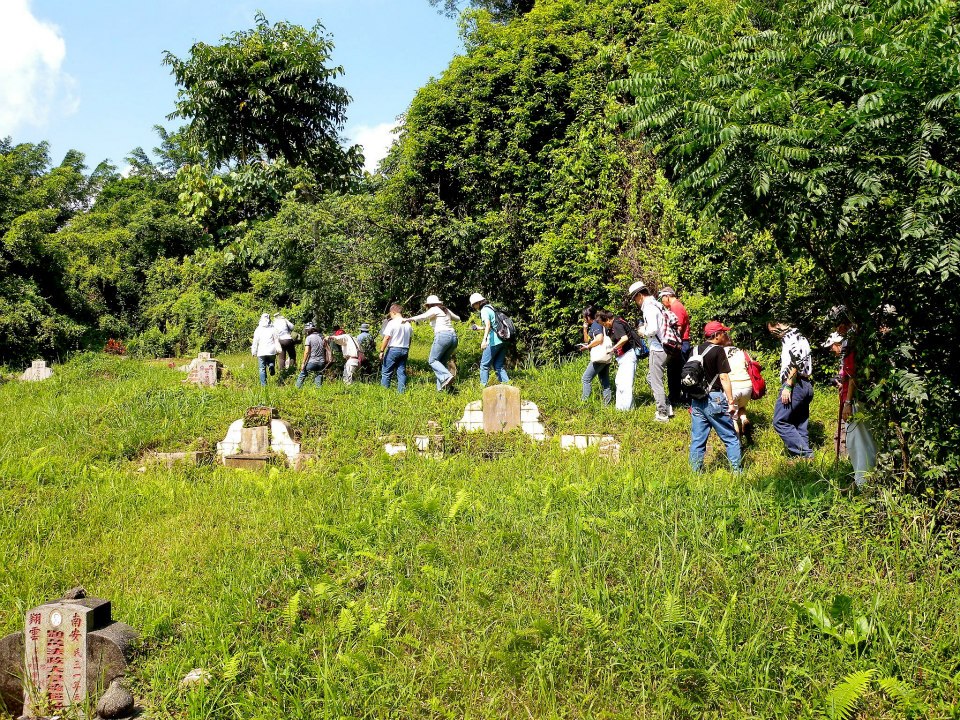
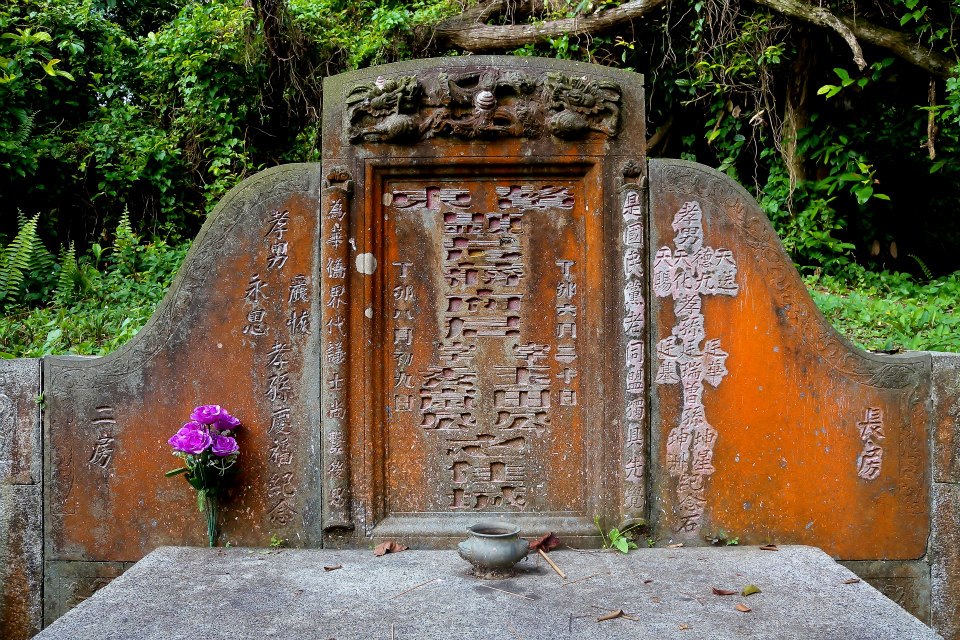
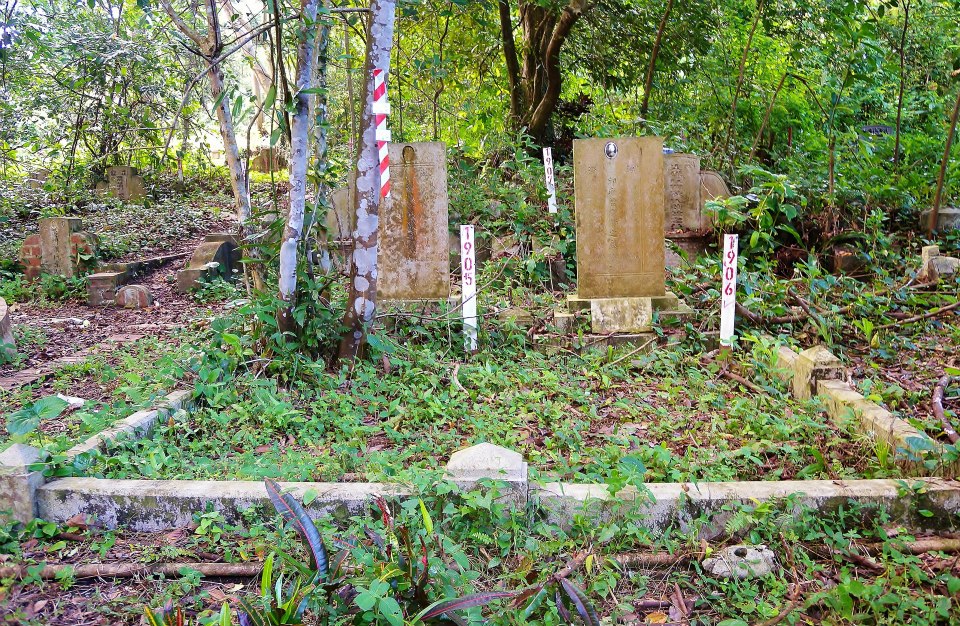

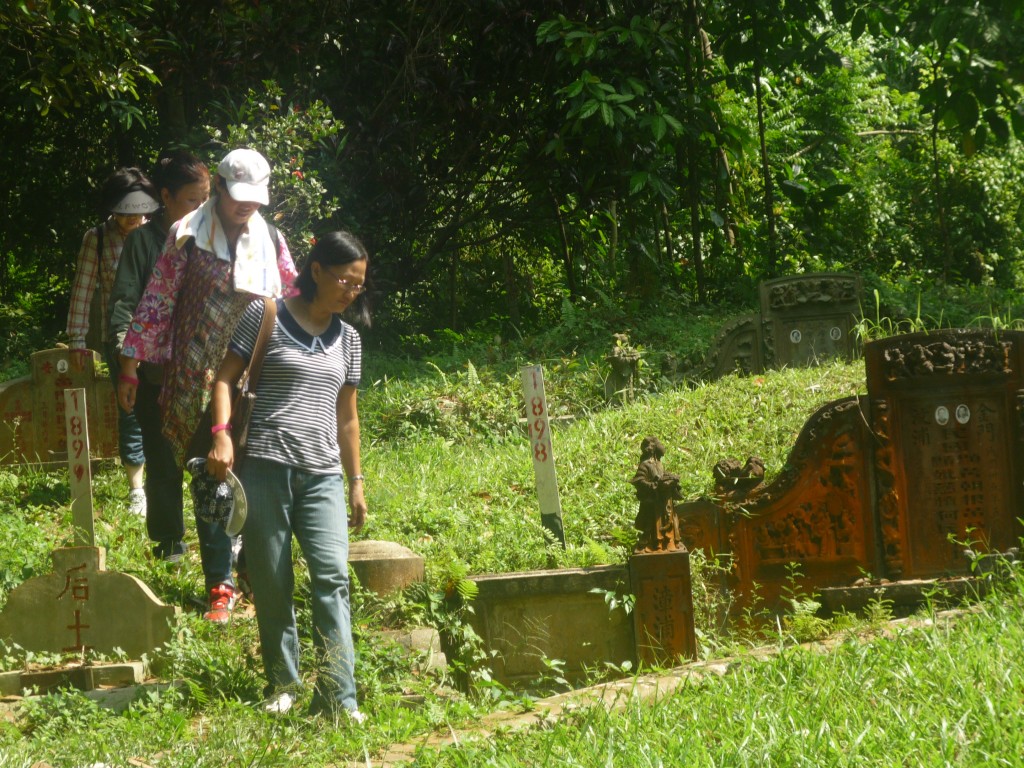
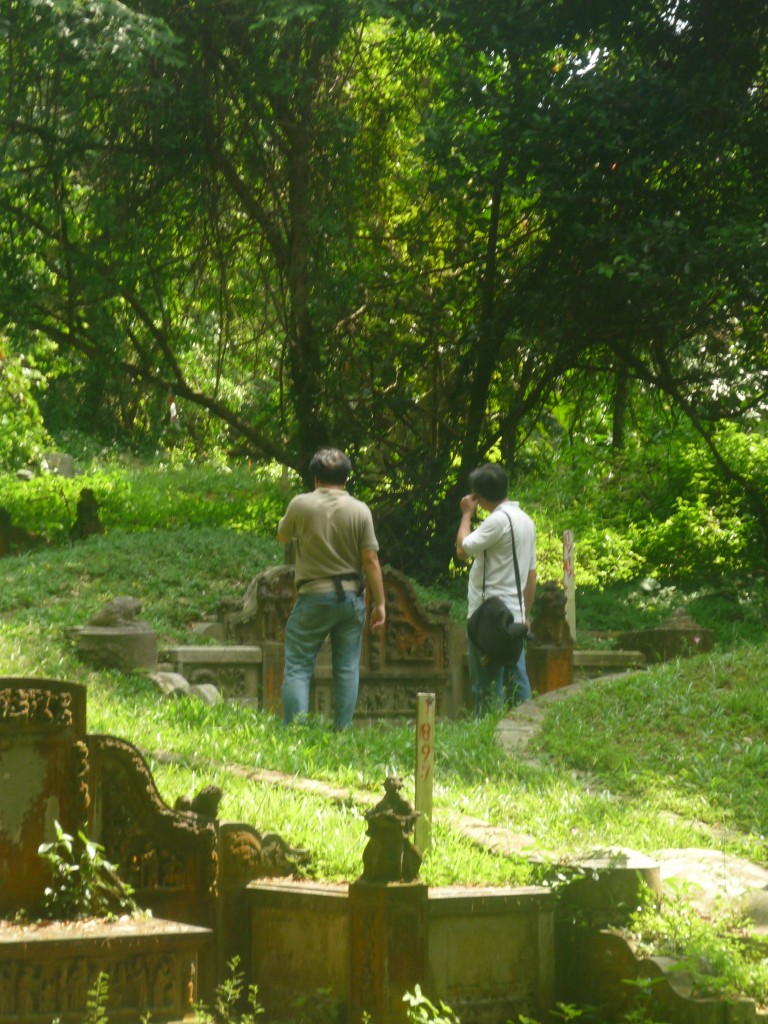
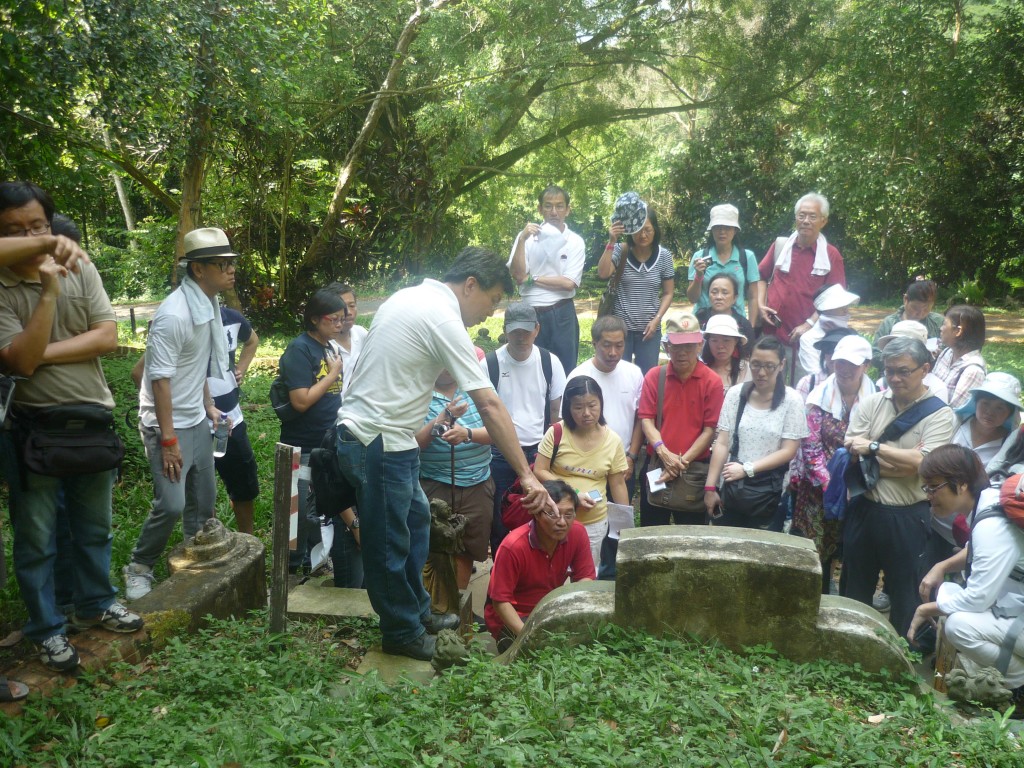
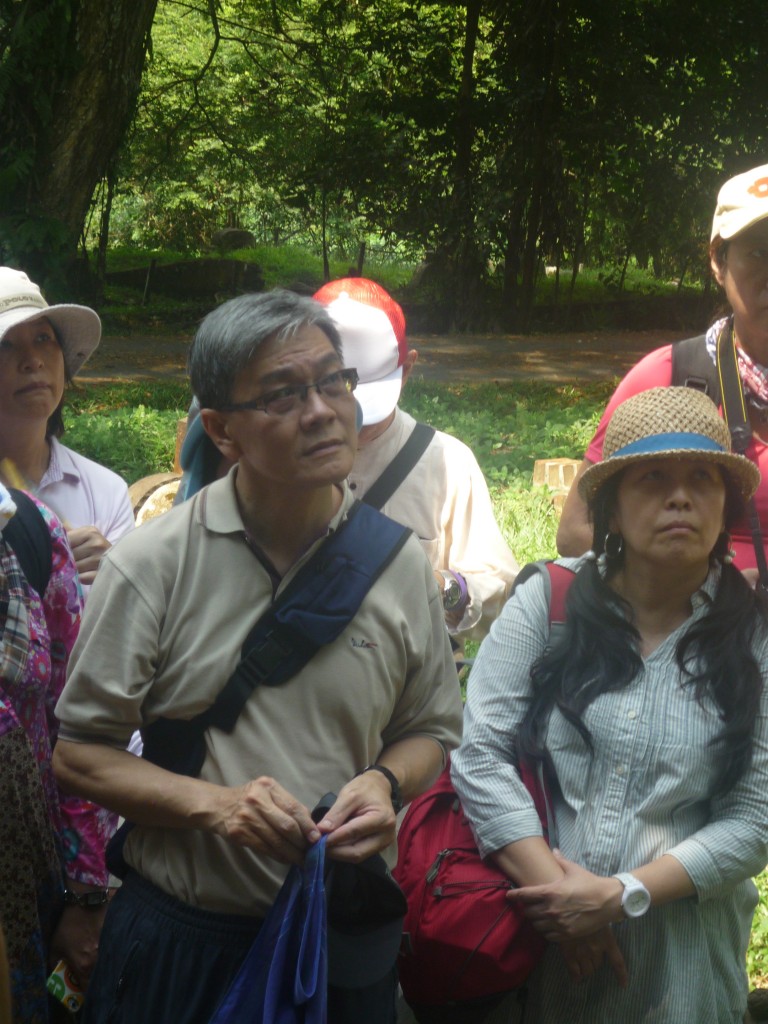
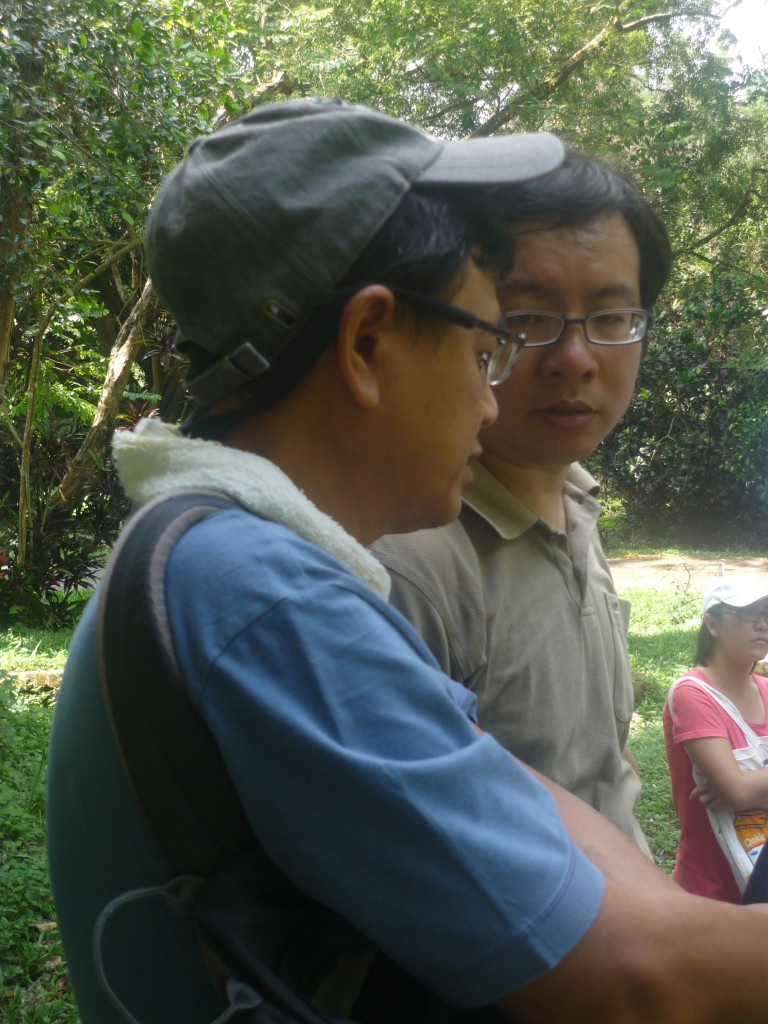
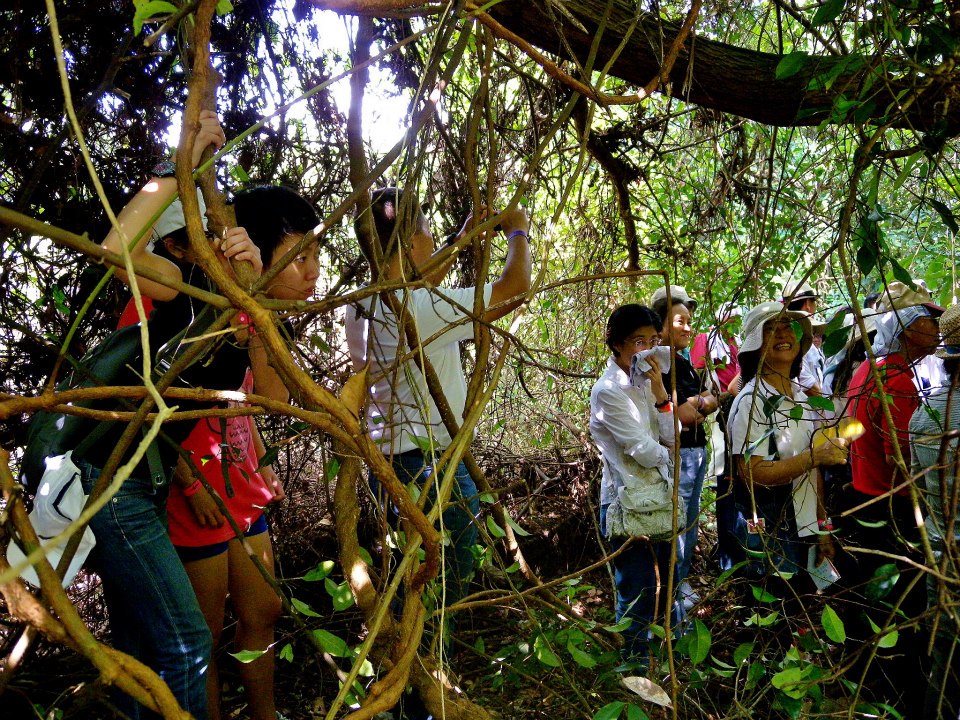

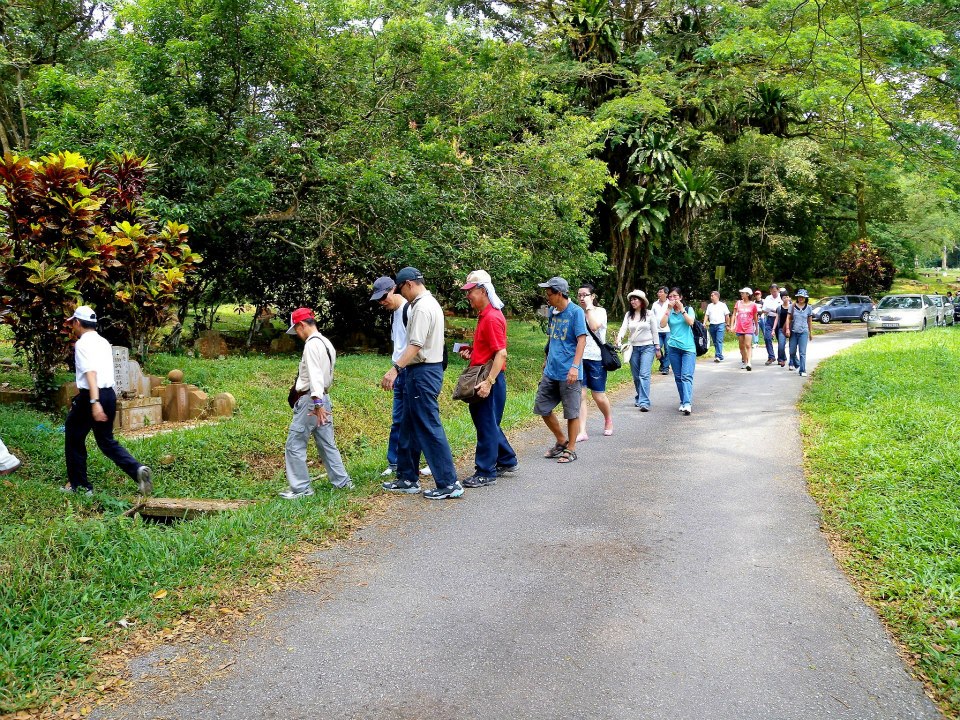
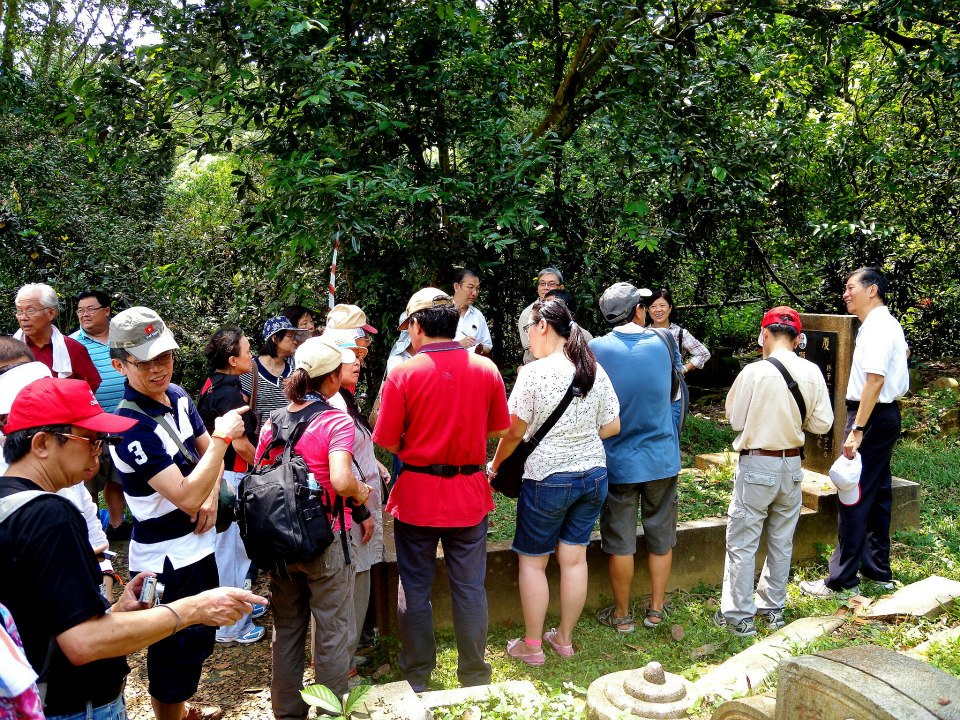
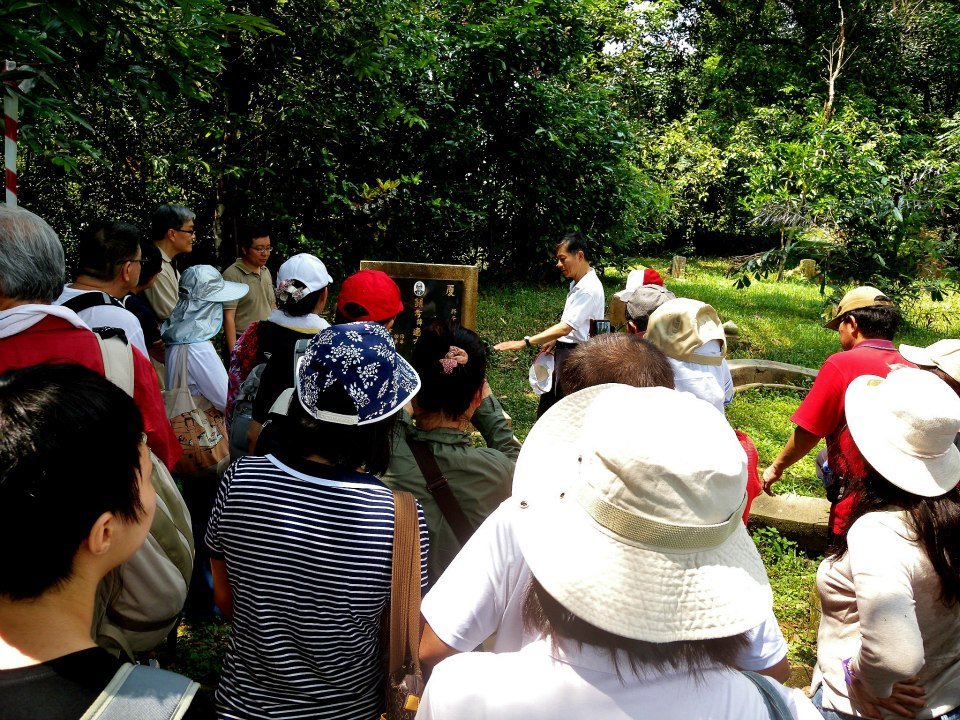


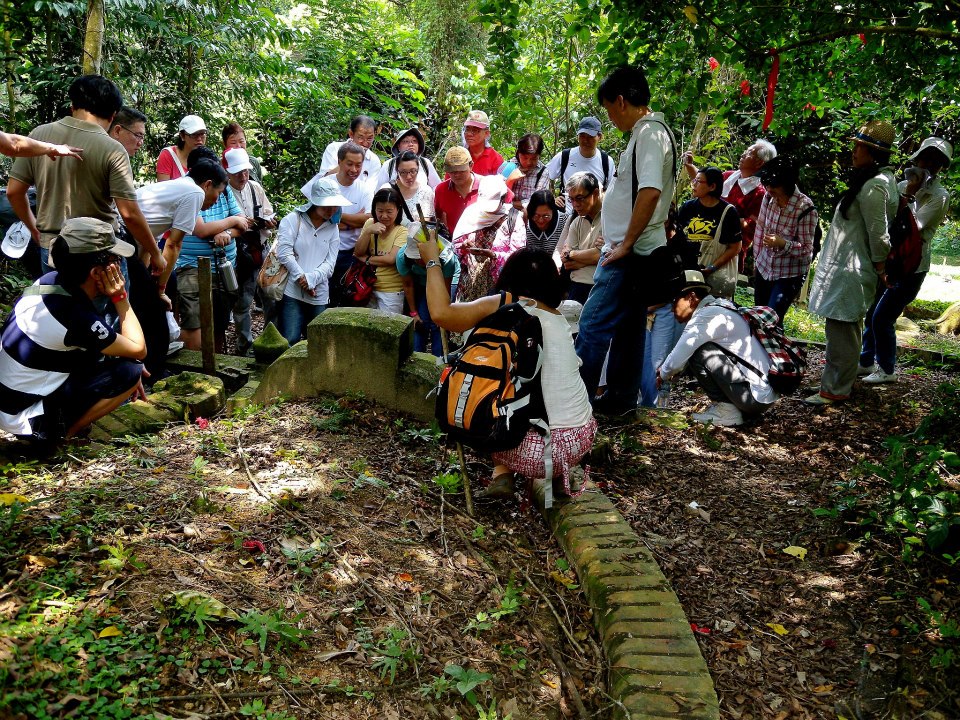
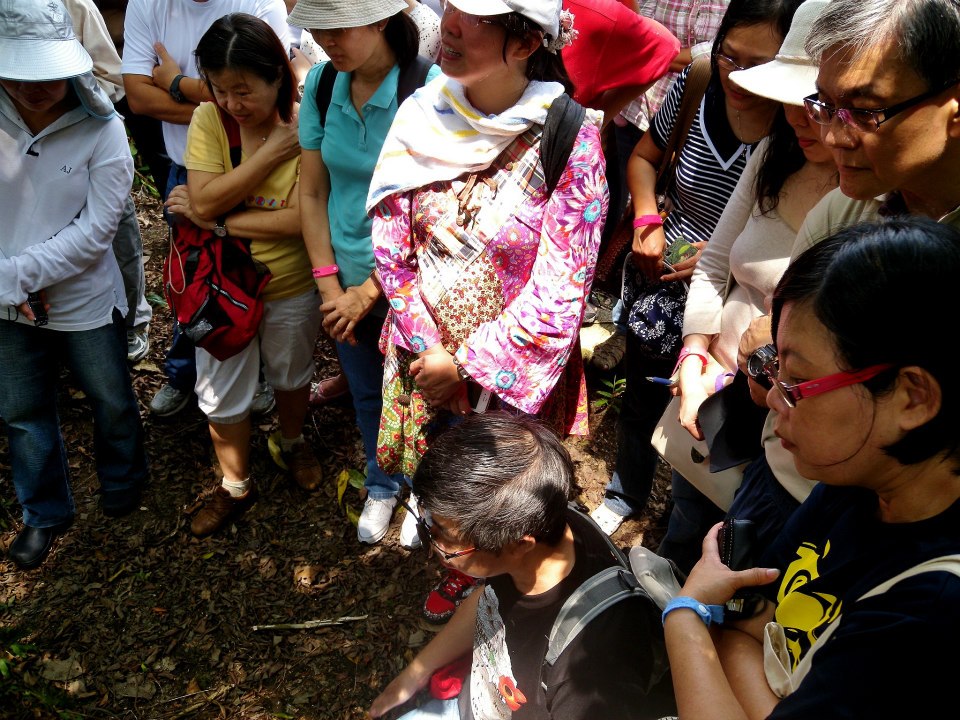

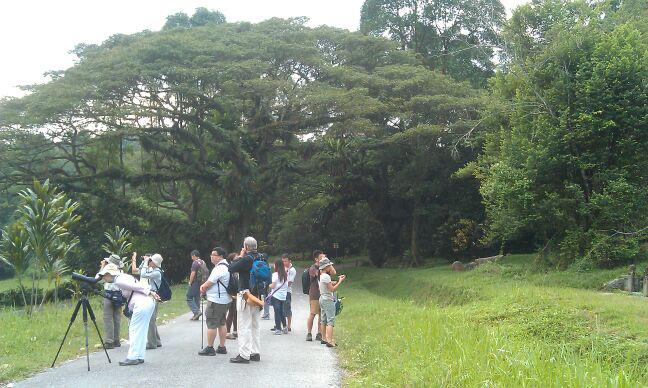
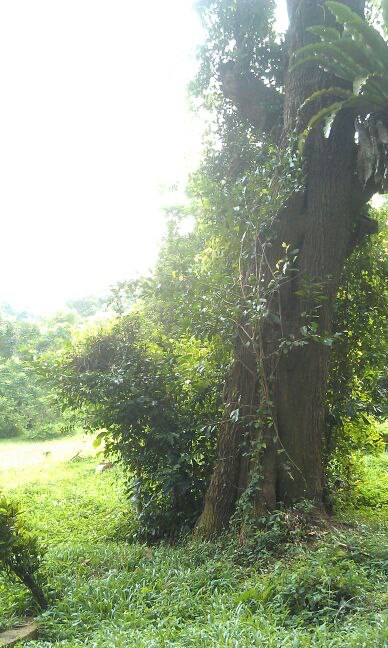
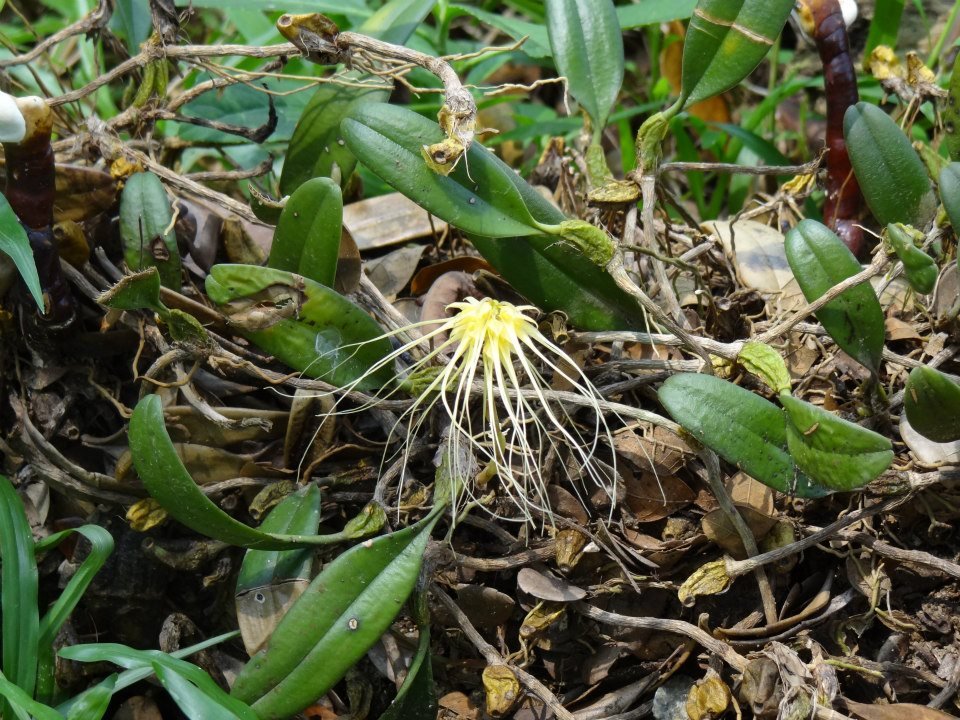
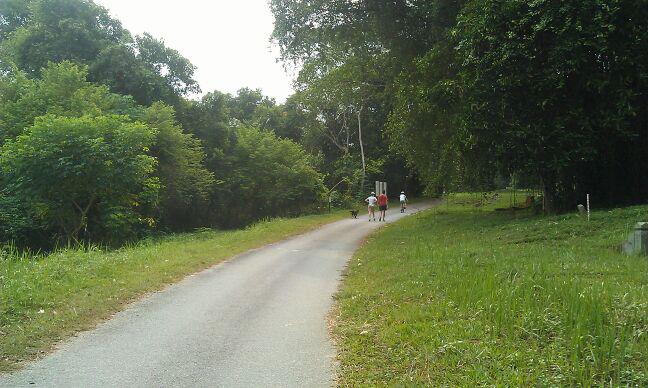
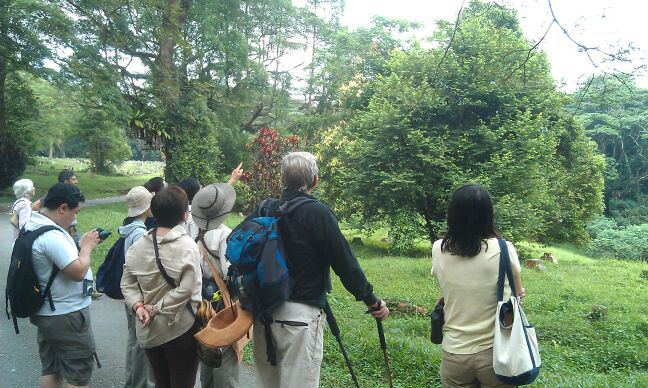

Recent Comments